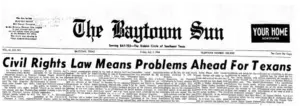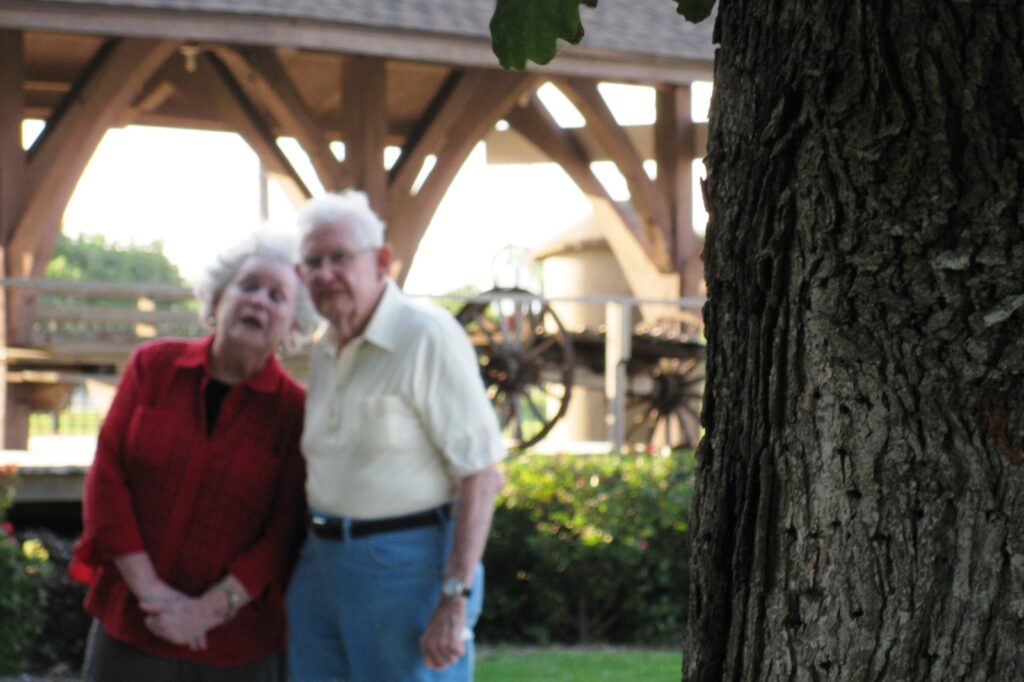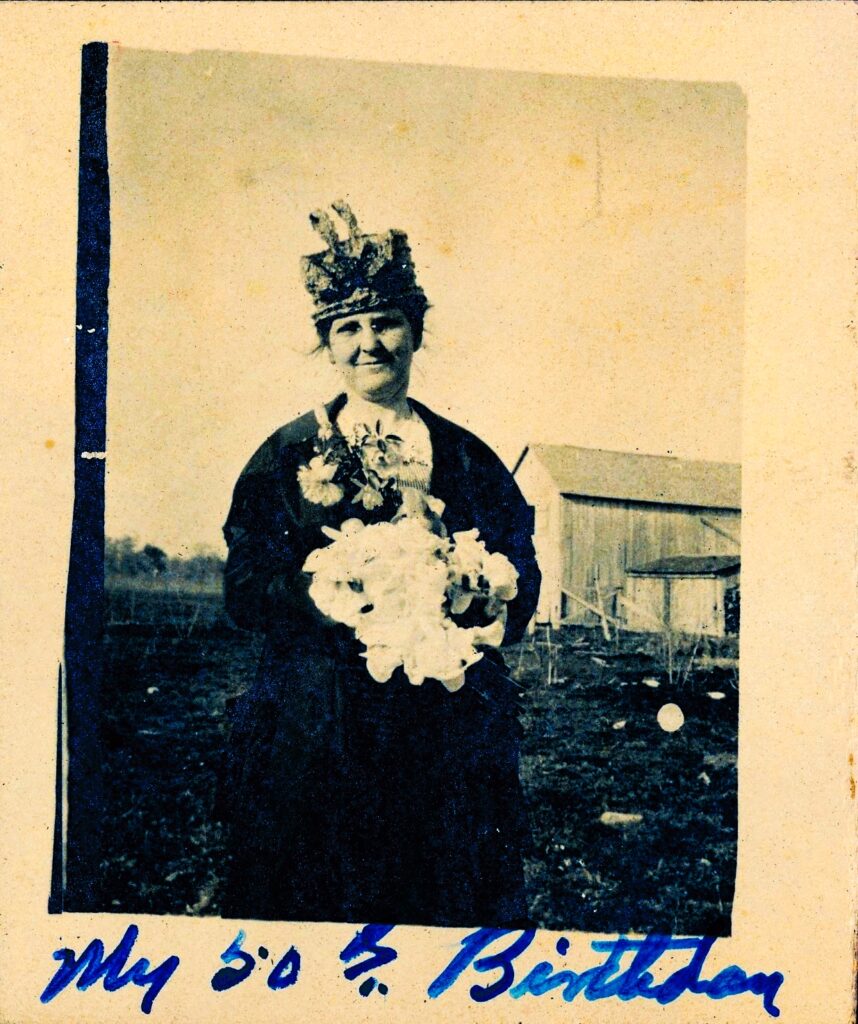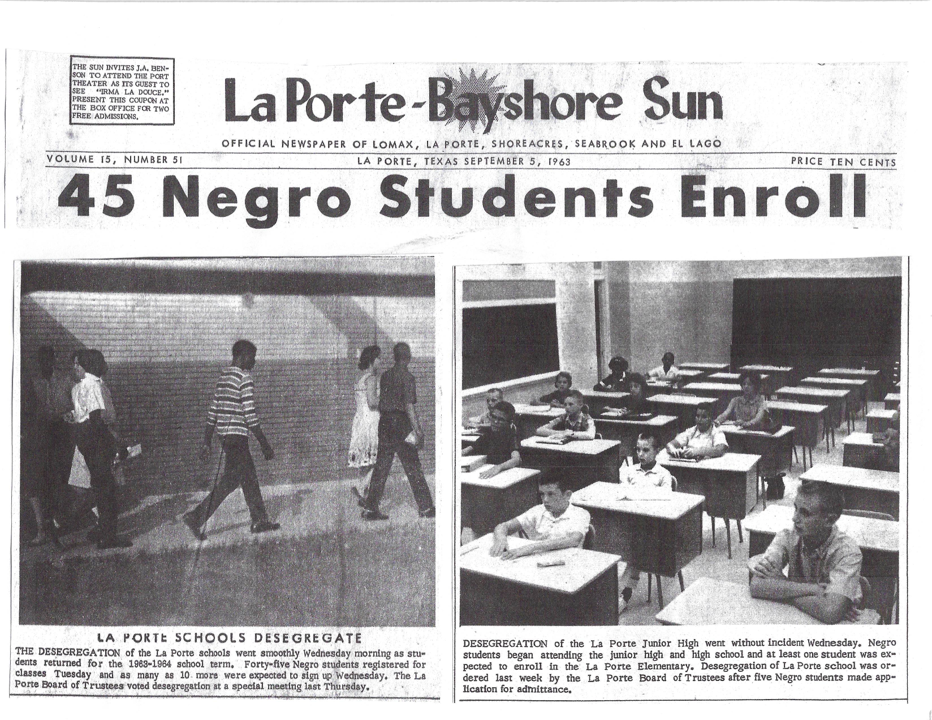
Little Red Schoolhouse
Before La Porte, Texas, was established, the only two schools east of Harrisburg were Morgan’s Point and Red Bluff schools. These one-room schools were painted the traditional “red” as it was the cheapest color of paint available and easy to make with local materials.
In 1885, before the founding of La Porte, the Red Bluff school, located on Todville Road in Seabrook (where present-day Casa Mara campgrounds are), was attended by the younger Harrises, Idlebrooks, Comptons, Edwards, Ballantines, Seureaus, and others. The Beazley children, who lived on Trinity Bay halfway between Morgan’s Point and Red Bluff, were taught at home by a tutor. These little red schoolhouses provided education from grades 1 through 8. Beyond the 8th grade, pupils had to travel to Harrisburg or Galveston by boat for their education since there were no roads or trains at that time.
Harris County Department of Education
In 1889, Harris County created the Harris County Department of Education, introducing a new concept for administering free public schools. This department encompassed all schools in Harris County.
Early History of La Porte, Texas
Incorporated on August 12, 1892, La Porte, Texas, is the oldest chartered town in East Harris County. During those first months, only a handful of children were in town, and school was taught in a private home at 206 South Third Street.
With forethought, the town Founders brought a teacher with them. Before an official school was established, Ms. Helen Haden, who had come to La Porte to act as assistant hostess at the Crescent Hotel, opened a kindergarten for very small children in her home on Third Street. Ms. Haden, the pioneer of early education in La Porte, was a flamboyant dresser with a wardrobe consisting mostly of evening dresses. Her unique character and style, particularly her red evening dress with a long train that swept the floor, never failed to amuse her young charges, who thought she was beautiful.
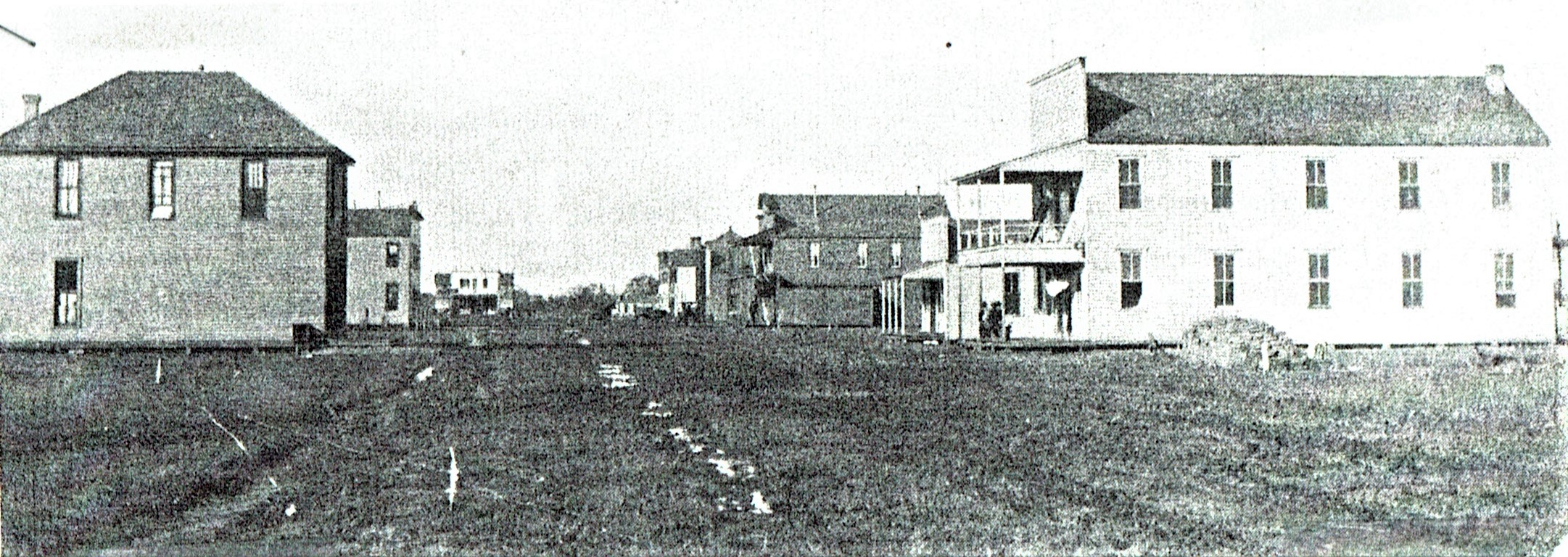
Main Street, La Porte, Texas (circa 1895)
A few months after La Porte was chartered, the Harris County Department of Education appointed La Porte residents A. N. Shannon, Dr. Henry F. McCoy, and Neil McNeill to act as school trustees for the new town, with Mr. Shannon serving as chairman. The trustees initially rented the Albion Prince building on the southwest corner of Main Street at Fourth to use as the schoolhouse. The 2-story, wood-frame building was located out on the bald prairie with plenty of space for a playground.
1892 La Porte’s First Schoolhouse
The first teacher, Ms. Abbie Newcomb of Augusta, Illinois, was invited by her aunt, Mrs. Alice Compton Marsh, to come to La Porte to teach at the new school. Classes were held in one room on the first floor, with one teacher and approximately 25-30 students enrolled at the school for the Fall of 1892. A male teacher was hired to keep the older boys in line, and Mr. Ladner was hired for the following terms.
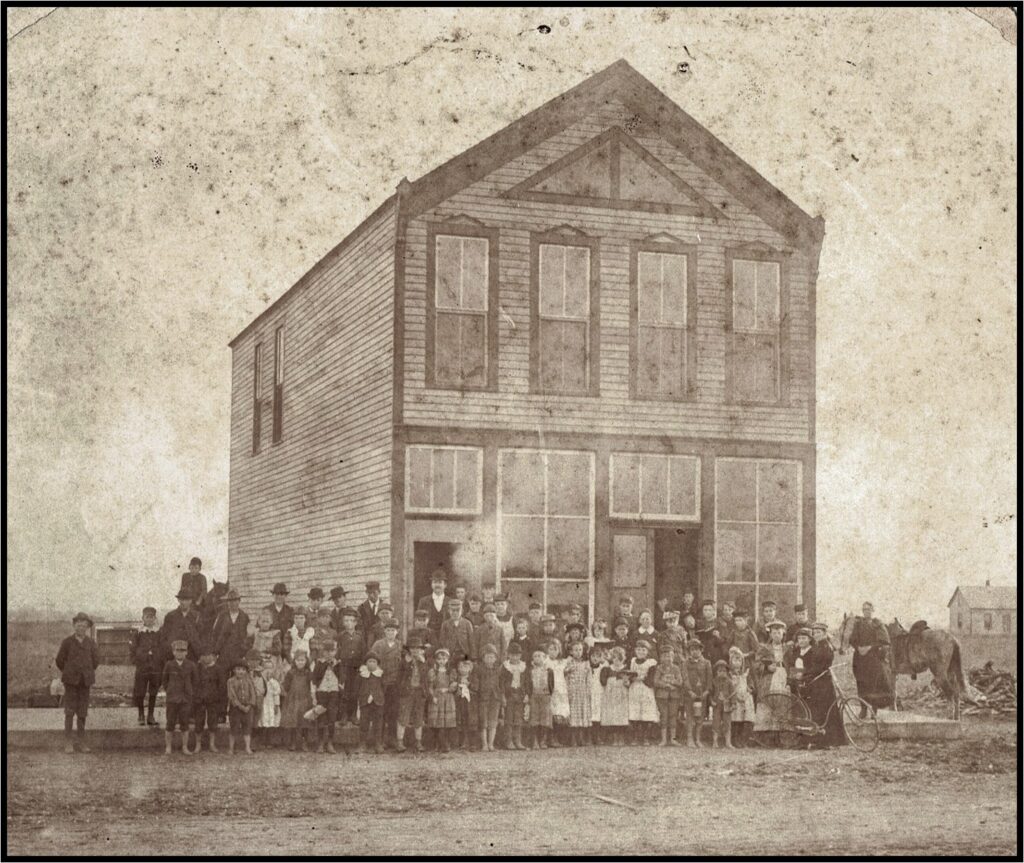
La Porte’s First School on Main Street (circa 1895). Mr. Ladner, teacher for the upper grades, is standing in the doorway on the left.
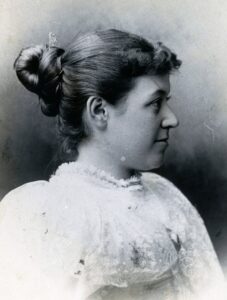
Abbie Newcomb was the first schoolteacher at the Main Street Schoolhouse. She taught the primary grades.
1896-1897 La Porte School
The 1896 reorganization of town leadership spurred a new wave of settlement, and the population of La Porte was increasing. The student attendance at La Porte had grown to 150.
Ms. Retta Work, whose family lived in Lomax, transferred to La Porte from Middle Bayou School, where she taught for a few years, to replace Mr. Ladner. Retta Work became La Porte’s first woman principal.
Retta was the professor over the upper grades, and Mrs. Alice Marsh, who took Abbie Newcomb’s place, taught the lower grades.
The school was, at this point, so overcrowded that classes had to be split up to accommodate all the children. The younger children attended school in the mornings, and the older students attended in the afternoon.
Unfortunately, the town did not have sufficient funds to hire a third teacher, and students over the 8th grade had to travel by boat or train to Galveston or Houston for their higher education.
1897-98 La Porte Gets a Second Public School
By 1897, the population of La Porte, now five years old, had grown considerably, and with it, the student enrollment. The town faced two problems: One was that Main Street had become too busy with the increase in the town’s population and was not the proper place for a school, and the second was the need for a larger public school somewhere away from downtown.
Stepping up to the challenge, the president of the La Porte Land Company, John Caplan, a Galveston realtor then living in La Porte with three school-age children, put forth a solution. Mr. Caplan agreed to donate six lots at the northeast corner of Second and C Street, which at that time was out in the prairie. His land donation came with the stipulation that the citizens of La Porte would pay for the lumber. He also offered his assistance with the construction of the school.
School Trustees P. W. Henderson, J. D. Hess, Sr., R. R. Lomax, and A. N. Shannon were unable to pass up the offer and called an open meeting at the Main Street School to put forth Mr. Caplan’s proposal. During this meeting, the trustees took subscription pledges from the citizens of La Porte to fund the school’s construction. John Caplan, who had been a chief crusader for the new school, pledged the first $100 and an additional $25 on behalf of his young son, Jacob.
It was reported that the room broke out in shouts as one could hear individuals calling out $25, $10, and $5, each giving what they could afford. In the end, $530 was pledged that night, and others pledged more in the following days.
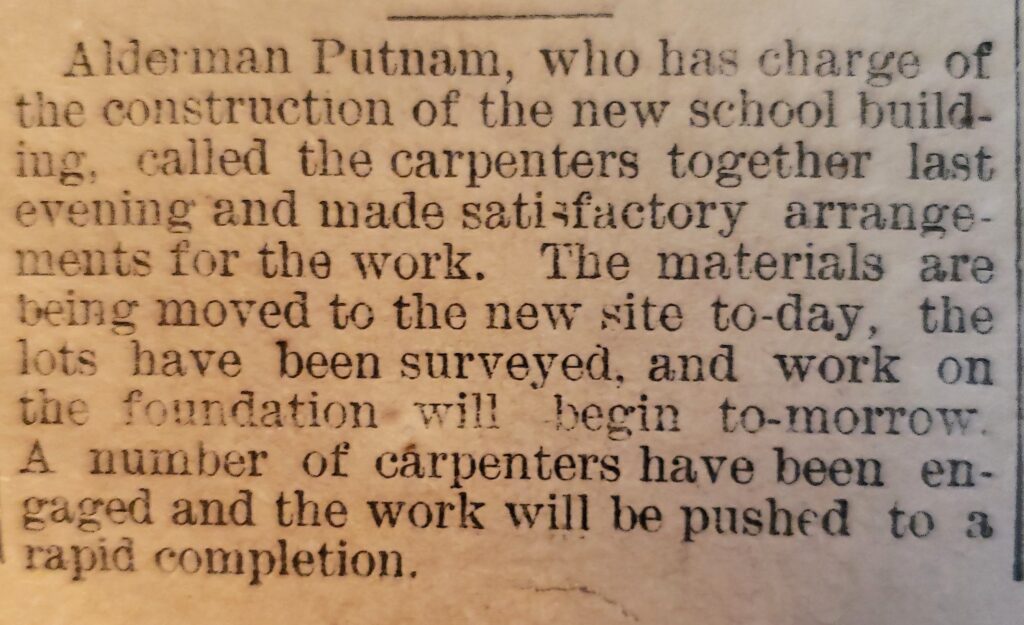
The La Porte Chronicle, March 12, 1896
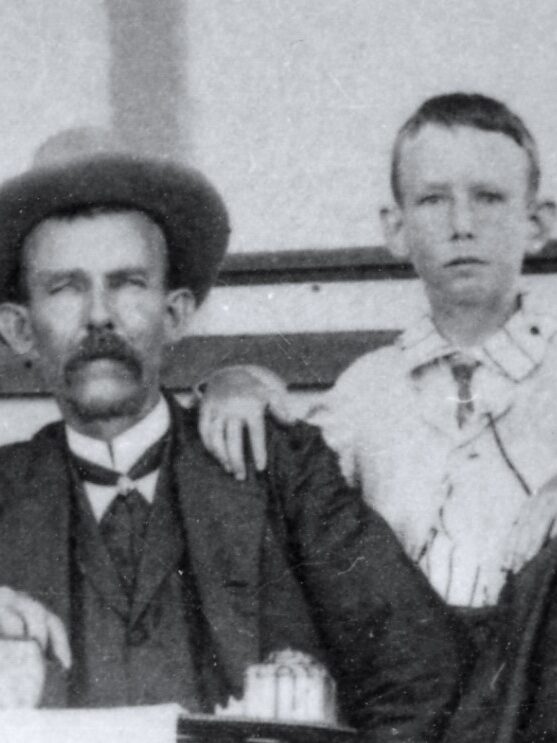
John Caplan and son, Jacob (1895)
With sufficient funds in place, plans were drawn up, and the townspeople immediately went to work on the new school. The building was spacious with 40 x 60-sq.ft. floor space, two stories, and a total of four large rooms. There were two rooms on each floor, with cloakrooms running through the center of each floor. Each classroom was furnished with desks and had a blackboard. At the time, the two-story school building was thought to be sufficiently ample to accommodate all the town children for many years to come.
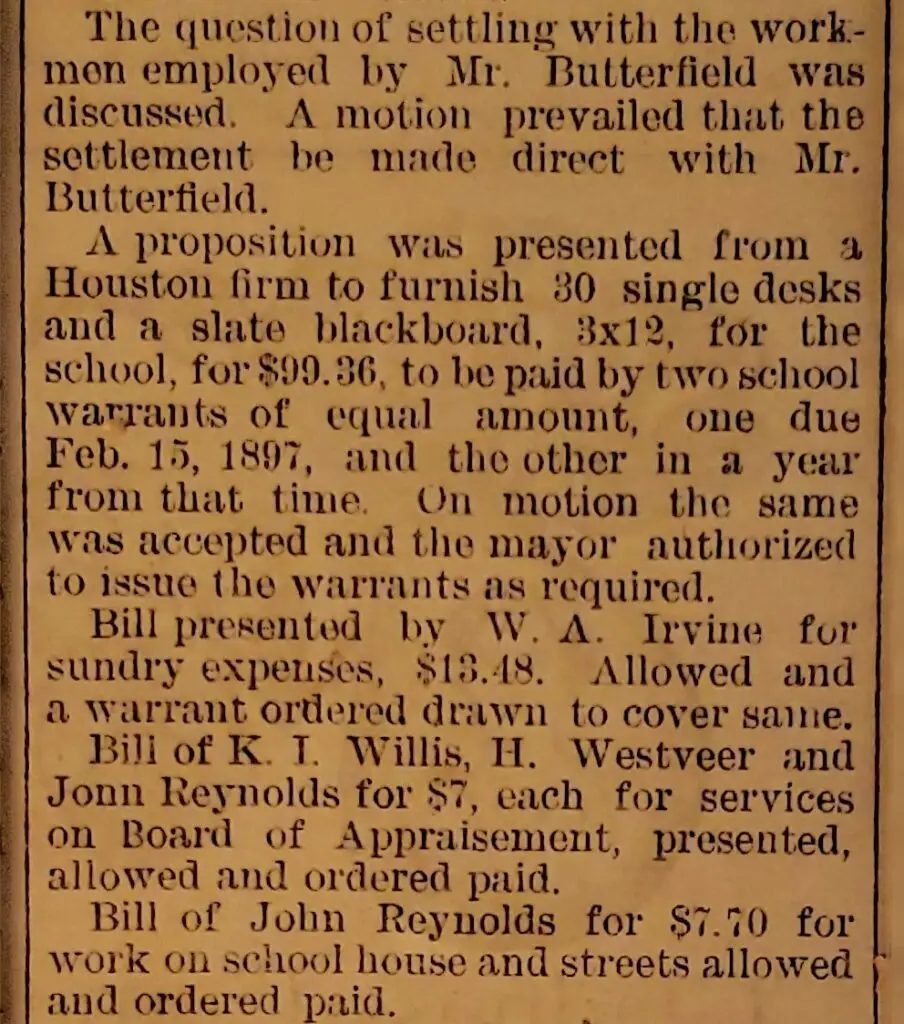
The La Porte Chronicle, July 16, 1896
The need for additional classroom space was so urgent by the Fall term in September of 1897, that it was necessary to start the school year in the unfinished building. This delayed the completion of the building until the summer of 1898. Tuition for all grades was $0.75 per month per student for the 1897-1898 school year. Only three classrooms were used in the first year.
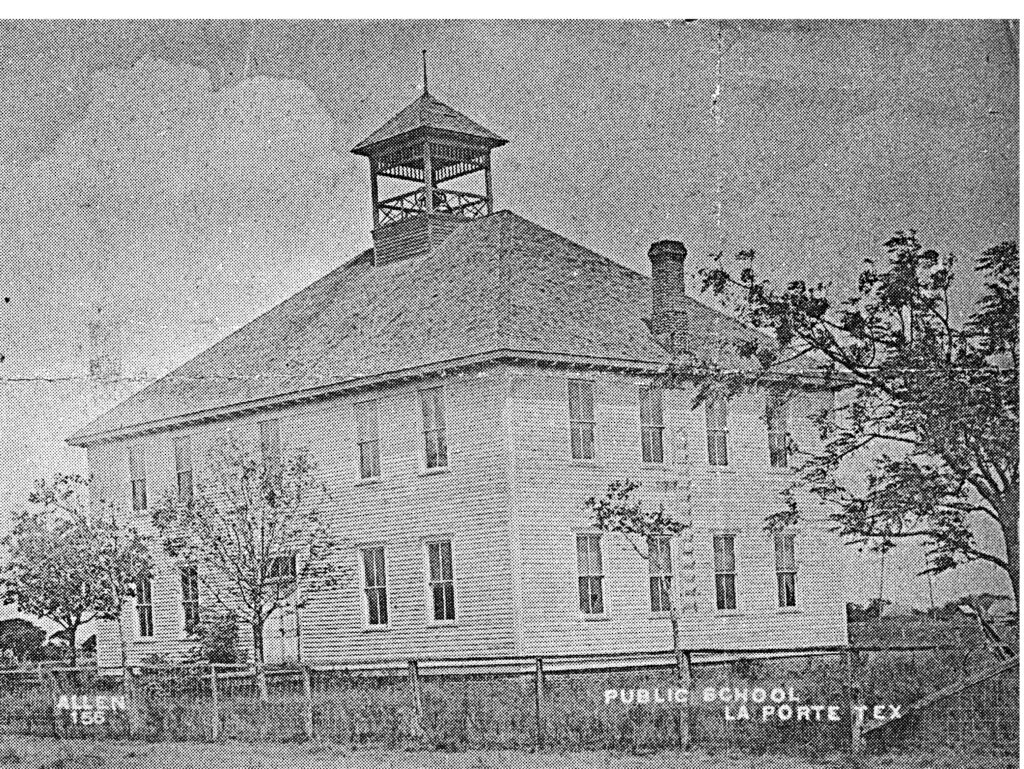
La Porte’s New Two-Story Public School opened Fall Term 1897 (Allen #156, taken 1911)
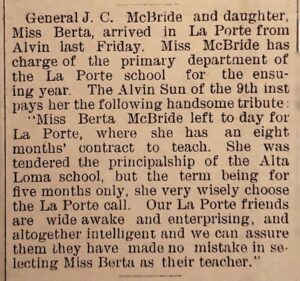
The La Porte Chronicle, September 15, 1898

1896 Lomax School Class Photo
1896 Lomax School
In 1896, the population of the farming community of Lomax, west of La Porte’s downtown, increased as well. The church building that was used for the school lacked sufficient space, and a new school building was constructed.

The La Porte Chronicle, March 26, 1896

The La Porte Chronicle, July 16, 1898
1898 Morgan’s Point School
Morgan’s Point outgrew its one-room school, and a two-room building was erected in 1910. Here, the children of the Nelsons, Coles, Arthurs, Pizzatolas, Roberts, and other families of Morgan Point were educated. The school became part of the La Porte School District when it was established in 1915.
1900 La Porte, Texas
The population of Texas was 3,048,710, and the population of Houston was 44,663. The town of La Porte was eight years old and had a population of 537. There were 33 Black citizens.
1900 Galveston Storm
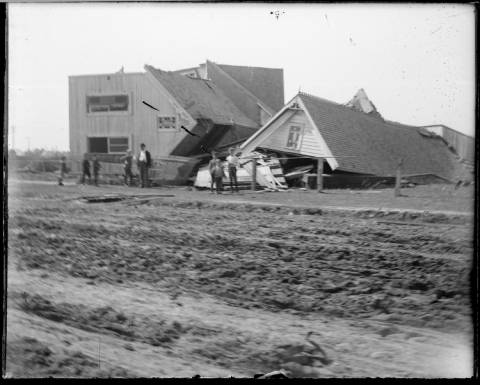 Morgan’s Point after the September 8, 1900, Storm
Morgan’s Point after the September 8, 1900, StormThe winds of the 1900 storm that washed over Galveston Island on September 8, 1900, made their way to La Porte just days before the start of the fall school term. As a result, all across town, from Sylvan Beach to Morgan’s Point to Main Street, homes and businesses were knocked off their foundations, some getting blown onto their side or destroyed completely.
Furthermore, the new school building on Second Street did not escape damage. It was knocked off its foundation during the storm, and its windows were broken, resulting in minor damage overall. The delay in starting the school term took several weeks until the building was placed back on its foundation and the other repairs were made. The former school on Main Street, now the Methodist Church, was damaged beyond repair.
1903 First Graduating Class
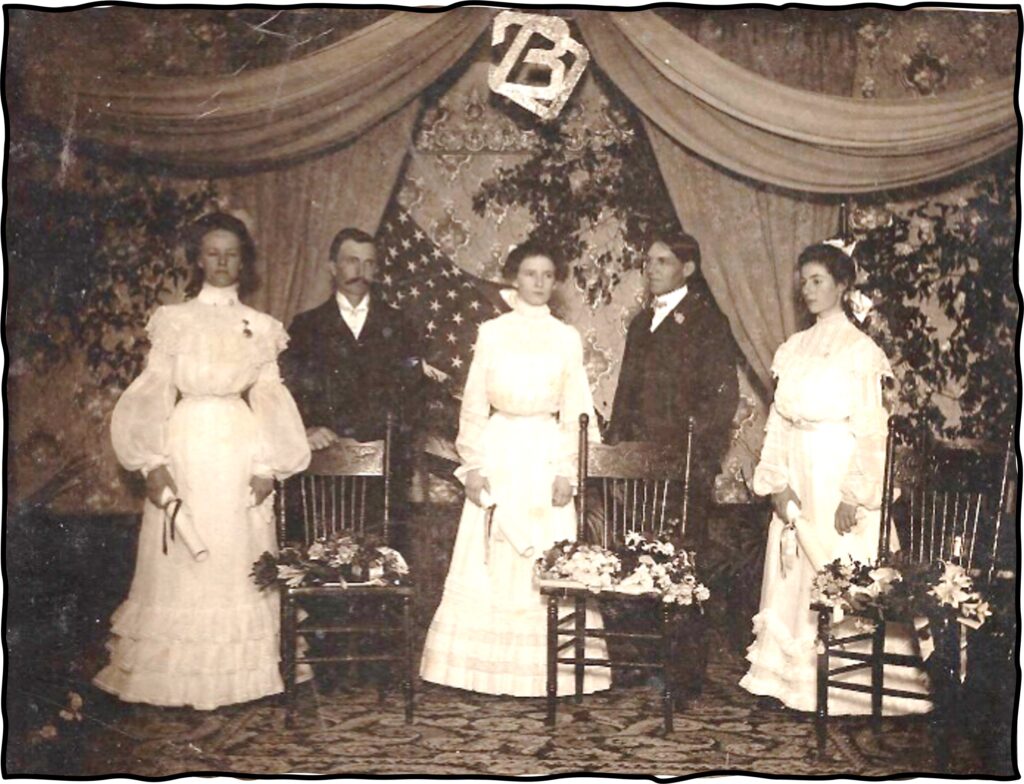
1903 First Graduating Class of La Porte High School – Graduates: (L-R) Grace Almira Stout, Laverne Adeste Morris, Besse Penn Shannon; Presenters (L-R) Harris County School Superintendent William S. Fry, and A. O. Blackwell, City Attorney
In the spring of 1903, the first class of the La Porte School was ready to graduate. There were three graduates, all girls: Grace Almira Stout, Laverne Adeste Morris, and Besse Penn Shannon. Ms. Shannon was La Porte’s first valedictorian and the first individual to receive a diploma from the La Porte High School system. The Class colors were old rose and green, and the class flower was Pink La France Carnation. The Class Motto: “To be rather than to seem.” It was an eventful day for the citizens of La Porte, and the graduation ceremony was held at the Baptist Church, which was the only building in town large enough to hold the crowd.
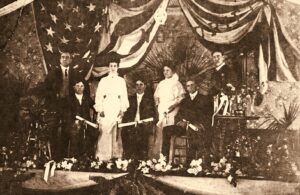
1904 La Porte High School Graduating Class – Graduates: Millie Lamb, Ola Carr, John Beazley III, Swan Compton, and Ward Figley
1905 School Money Woes
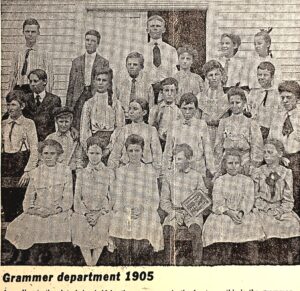
Following the Depression of 1903, the eventual splitting up of La Porte into Old La Porte and New Town, charges of election fraud, and the town’s ongoing attempts to sort property ownership and collect back property taxes, school funds were taking a hit. As a result, Professor and Mrs. Harkness quit their jobs at the school because of pay, or rather, lack of pay.
The La Porte School tax and salary problems were resolved by the start of the 1905 Fall term.
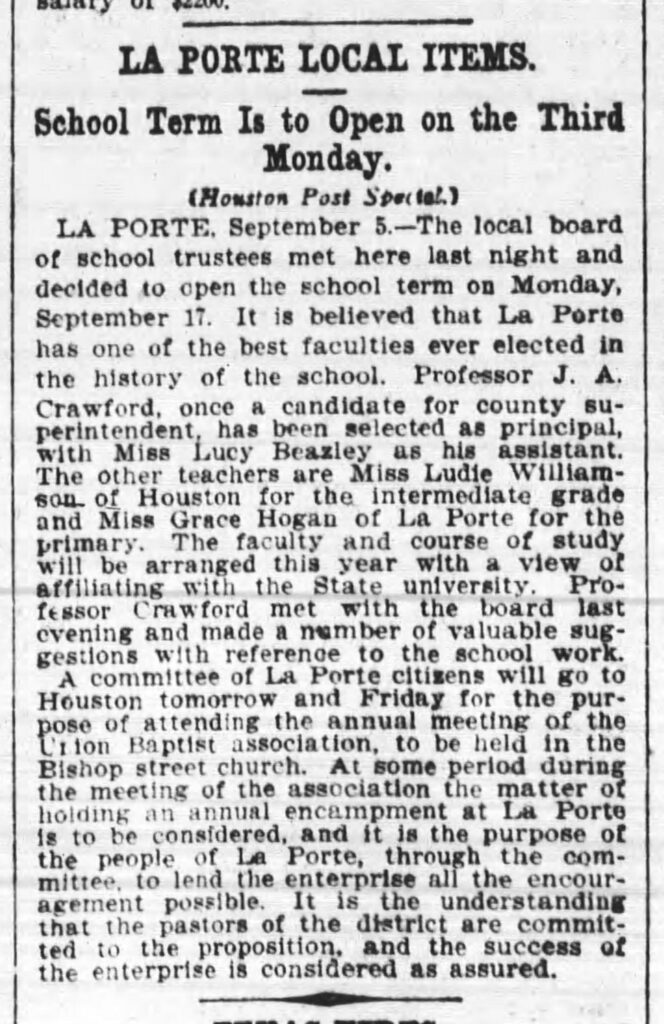
Houston Post, September 16, 1906
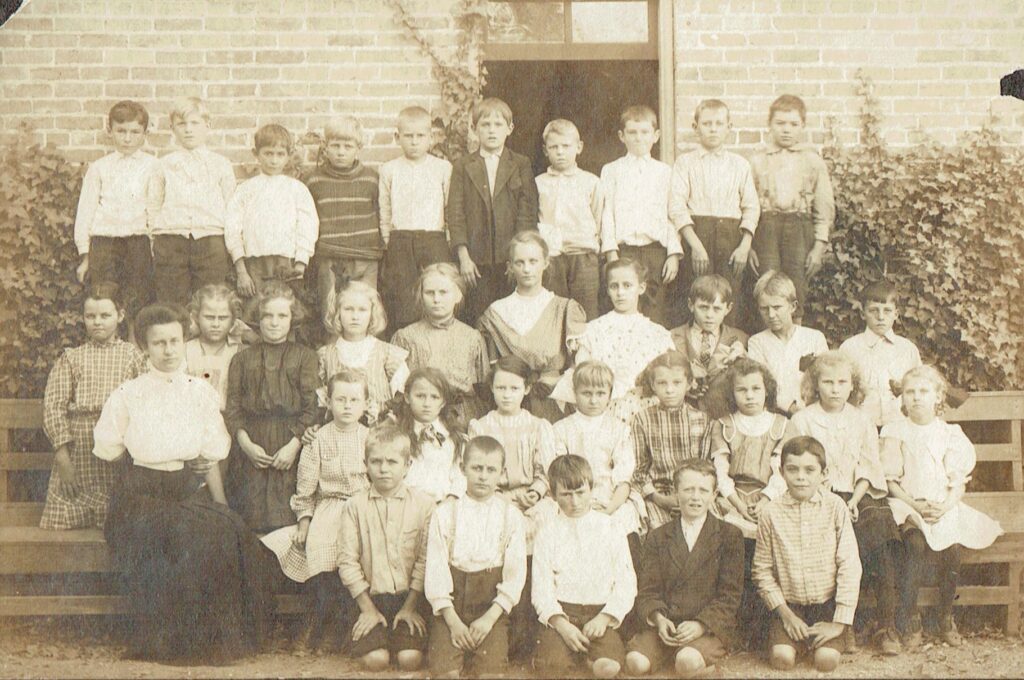
1908 La Porte Public School Primary Students

Viola Eady DeWalt (circa 1900)
1909 La Porte’s First “Colored” School
The Black population of La Porte was slowly increasing, and by 1909, there were about 8 to 10 school-age children. The La Porte School trustees formed a committee and hired its first teacher.
Viola Eady DeWalt, aged 29, was an experienced teacher from Houston who was hired as the first Black teacher for the new Colored School in La Porte, Texas. She received her teaching certificate from Prairie View Normal School in 1899 and had several years of experience teaching in Houston schools. She was paid a salary of $35 per month.
Since there was no dedicated schoolhouse and the class size was small, classes were held at the Zion Hill Baptist Church, a Black church established in 1907. The school trustees rented the church for $3 a month. The first term started in October 1909 and lasted for three months.

The first three years of classes at the Colored School were held at Zion Hill Baptist Church, established in 1907.
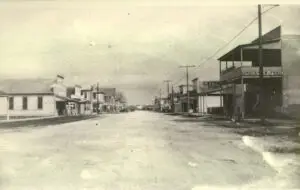
Main Street La Porte, Texas, looking East from Fourth Street. (Photo by Allen taken in 1911)
1910 La Porte, Texas
The population of Texas was 3,896,542, and the population of Houston was 78,800. The town of La Porte, Texas, was 18 years old and had a population of 678. There were 82 Black people, which increased the Black population by 50 over the 1900 census.
1911 La Porte School Growth
As the population of La Porte continued to grow, so did the student enrollment. By 1911, there were 112 students enrolled in the La Porte School: 22 high school, 33 intermediate, and 57 primary.
By 1912, 25 students were enrolled at the Colored School. The school term increased to four months, running from September to December. The increase in the Black student population prompted a need for a dedicated school. For the sum of $200, the School Trustees purchased and fixed up the abandoned Black Methodist Episcopal Church building, which had been repossessed a few years earlier by lumberman J.T. Baker.
The 1913 school year opened on September 2, 1913, in the new Colored School building. Teacher Viola Eady DeWalt was now paid $40 a month.

1913 One-Room Schoolhouse during renovations to become the La Porte Historic Colored School and Museum, February of 2018.
1914-1915 La Porte School District
The Goose Creek oil boom brought many families to the area. La Porte was especially popular for families with children since it had a reputation for being one of the better schools in the area. As a result, La Porte’s public school enrollment increased to 215 students.
Therefore, it was no surprise that by 1913, the two-story school on Second Street was not large enough to accommodate all the students. Even though the former Church of Christ building on “C” and Third Street was leased the previous year to make room for the primary grades, more room was needed.
For nearly two years, the school trustees discussed, but never finalized, the need for a new and larger school building. That was before Art Muldoon, president of the school board, took matters into his own hands. He called a special meeting of the school trustees to finalize the plans for a new school building. In 1914, the city held a bond election and unanimously voted to construct a new school. Land was secured, and plans were drawn for a grand 3-story brick school facility. Building it, however, was not as easy as anticipated. From the start, the project faced various obstacles, both human and natural.
In August of 1915, a hurricane delayed the planned September opening of the school for the 1915-1916 school term, and the school trustees were forced to continue using the Second Street school.
It was during this time that the La Porte School District was granted by a special act of the Texas Legislature in 1915.

1917 La Porte Board of Education
At last, in September of 1916, the 500-lb. school bell pealed out the tones of “Time for School,” and the new three-story brick school building located on “C” Street and Broadway opened its doors for the 1916-1917 school year. Board Chairman Art Muldoon called the building his “monument,” while his critics called it his “folly.” Situated on the land where La Porte’s first church once stood, the impressive structure drew proud citizens from all directions to attend the dedication. Businesses closed for the occasion, and the 500-seat auditorium was packed to standing room only.
The school building was truly outstanding and the finest in the county for a town the size of La Porte.
Board Chairman Art Muldoon called the building his “monument,” while his critics called it his “folly.
Attendance was open to high school-level students of the outlying districts of Morgan’s Point, Lomax, Lynchburg, Middle Bayou, Bay Ridge, Strang, and Seabrook until their districts received high schools. For the first couple of years, Mr. Lemuel Purdy, Sr., was hired to pick up the students from Lomax and Morgan’s Point and all points in between. Seabrook students came by rail, motor car, or private automobile.
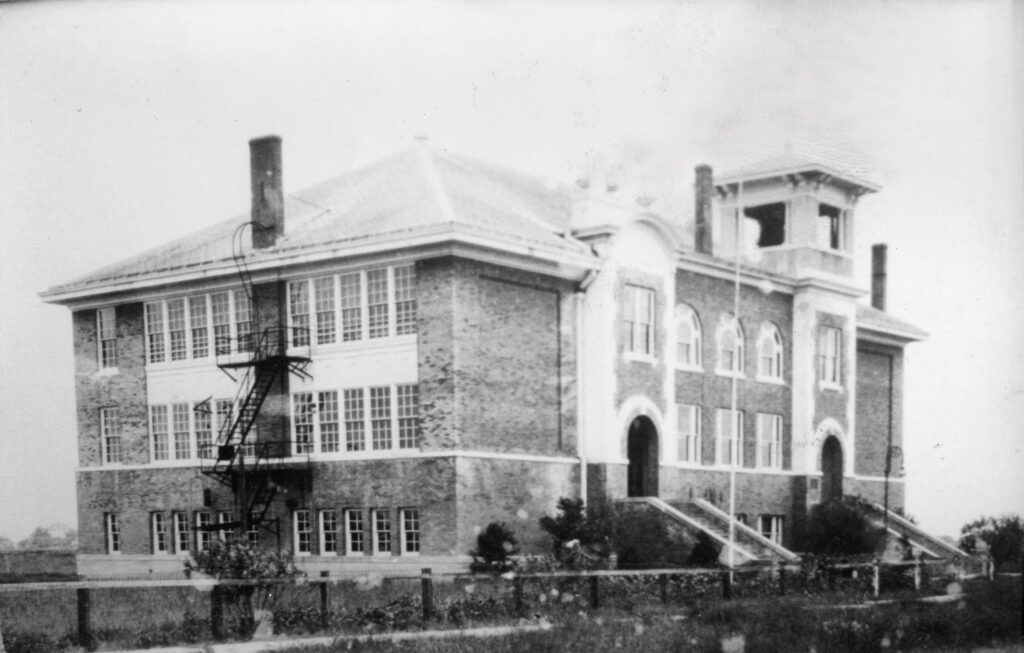
1916 Brick Three-Story High School
The old two-story school on Second Street, once the pride of early La Porte, closed its doors for the last time at the end of the Spring term of 1916. The land was sold, and the school was torn down soon after.
The last class to graduate from the old two-story school consisted of three students: Sybil Redman, Luther Casteel, and Willard Hovey.
1916-1917 La Porte School’s First Yearbook – ETROPAL
In 1917, high school students organized and published the first school yearbook. It was named “ETROPAL” for La Porte, spelled backwards. However, the initial publication was short-lived. Due to World War I in 1918, followed by the Depression, and paper shortage, no official school yearbook was published until 1935.
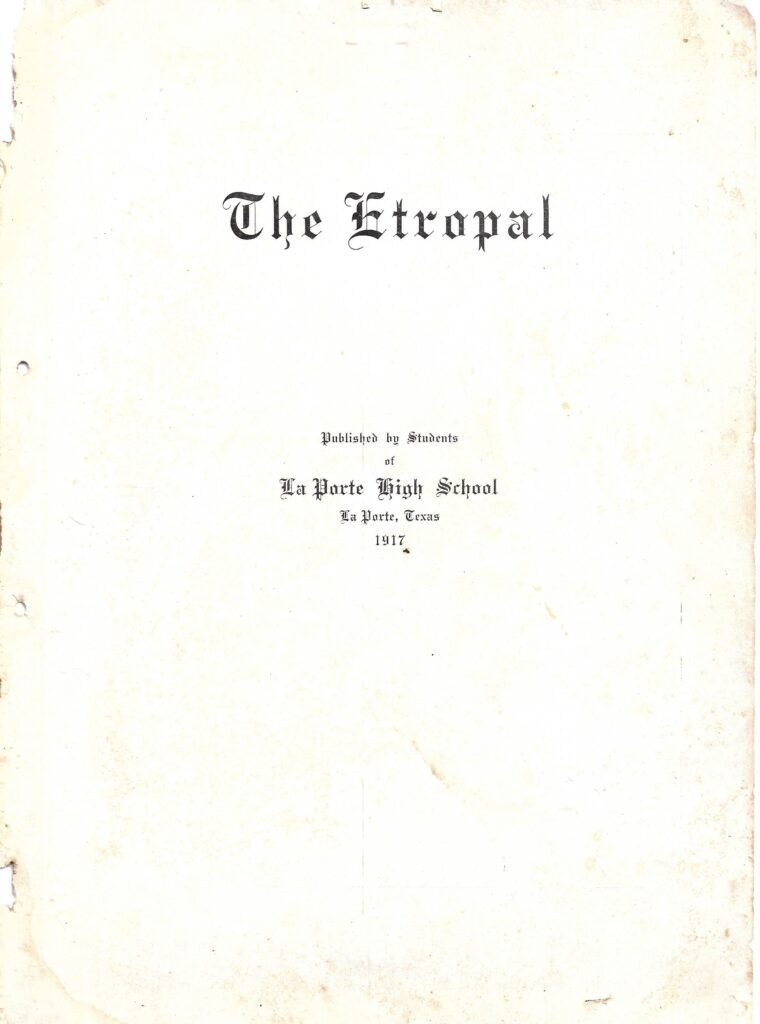
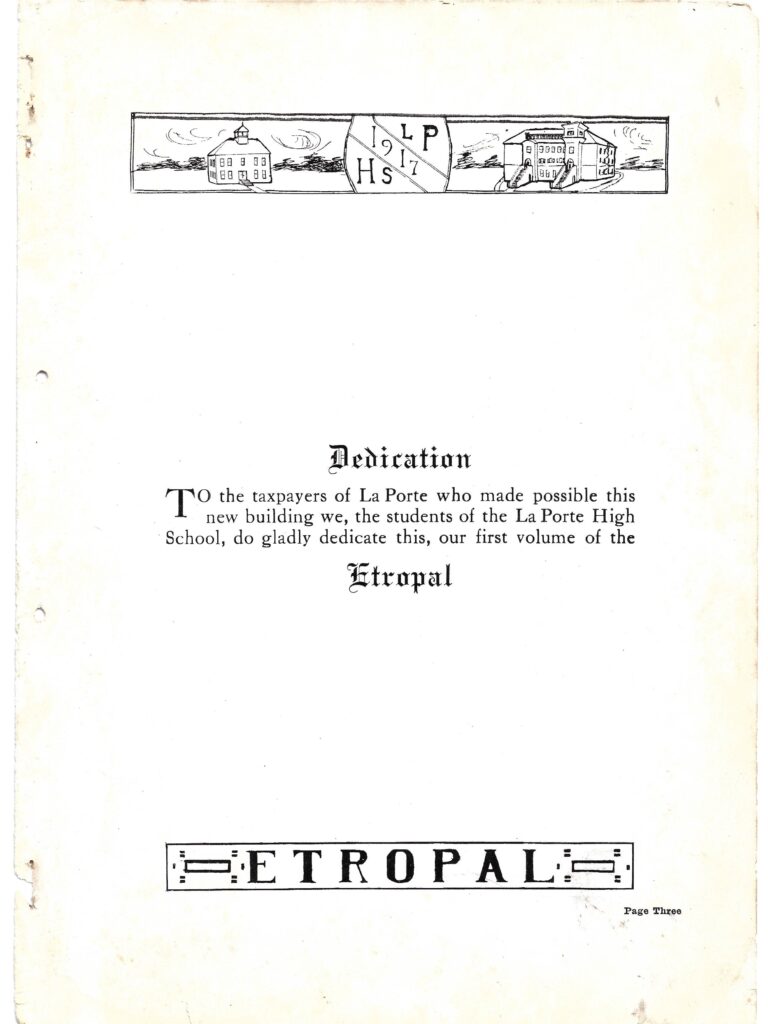
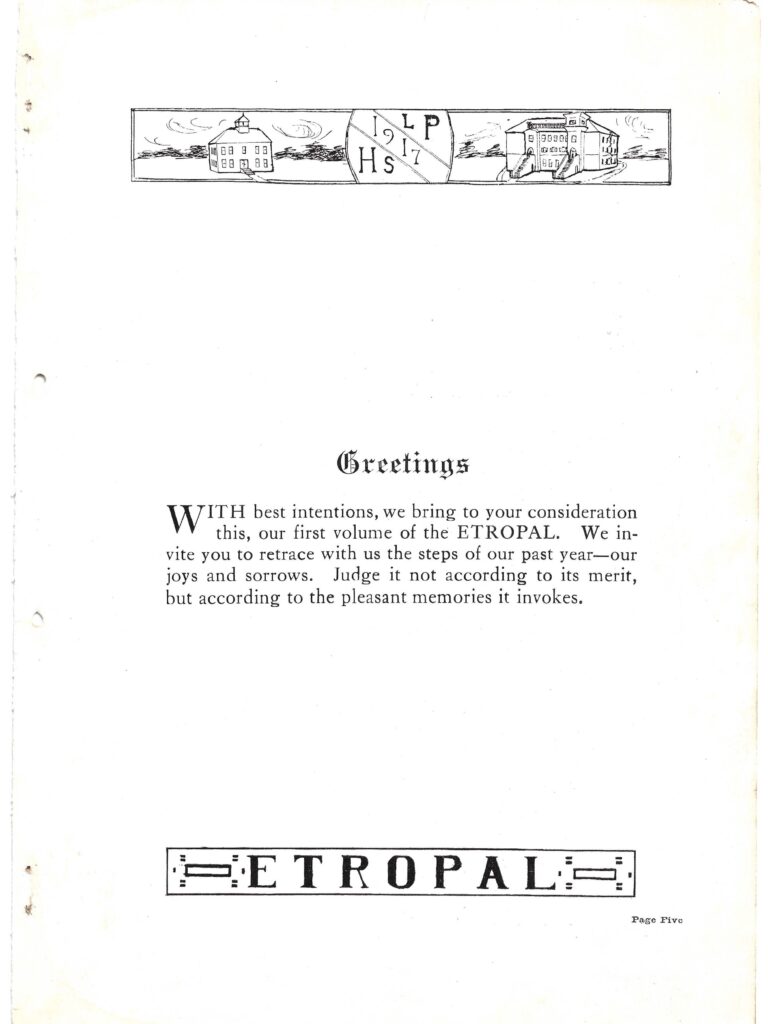
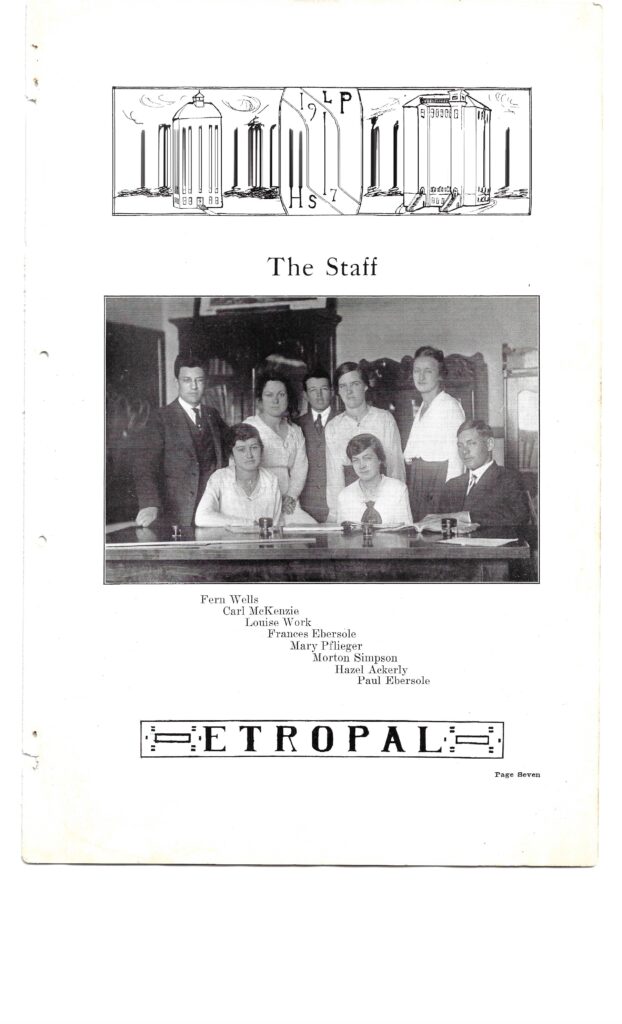
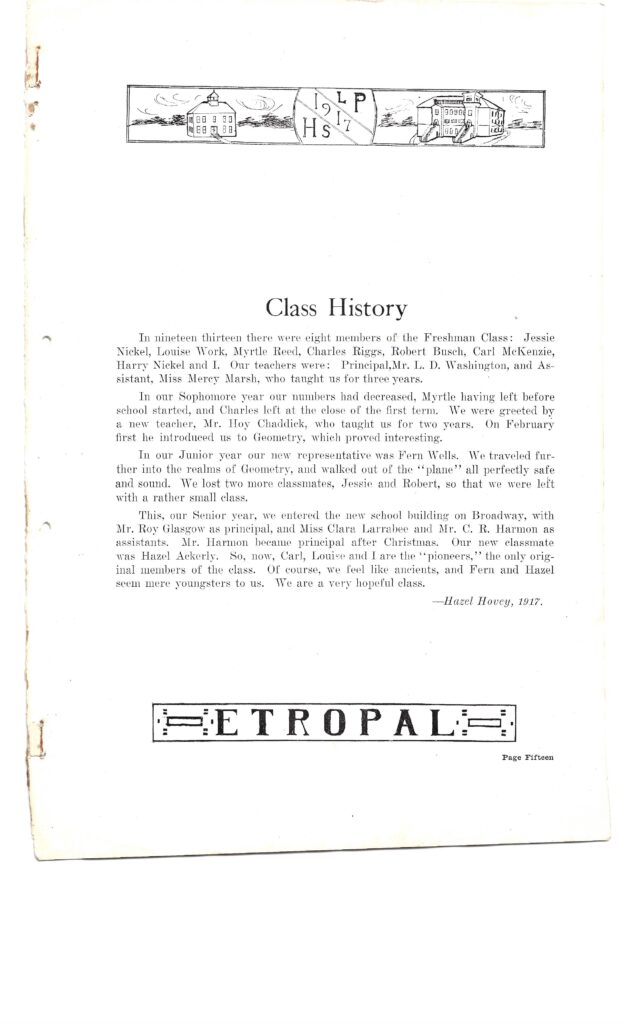
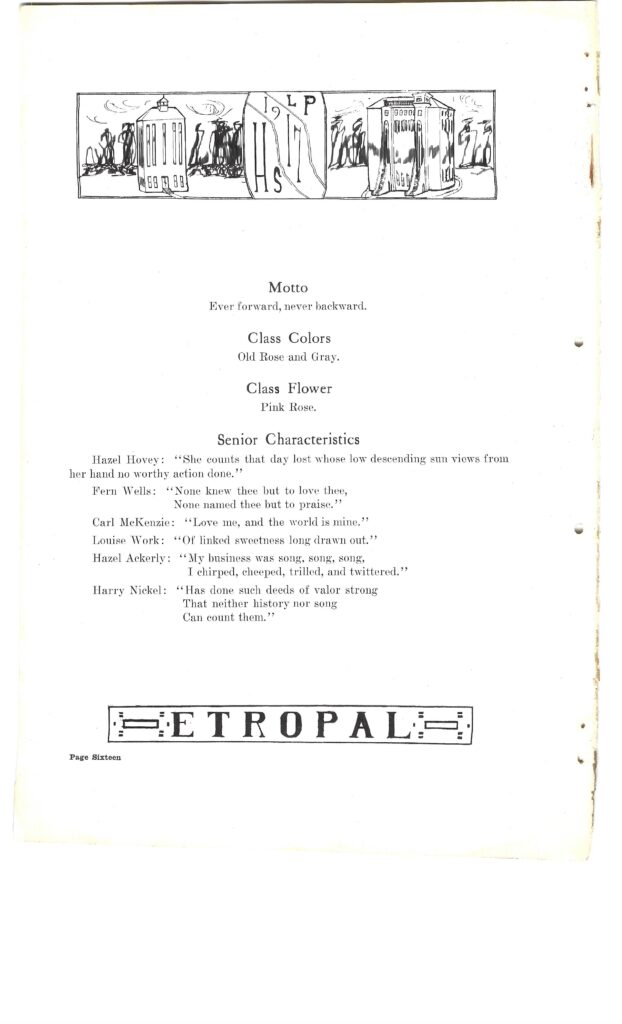
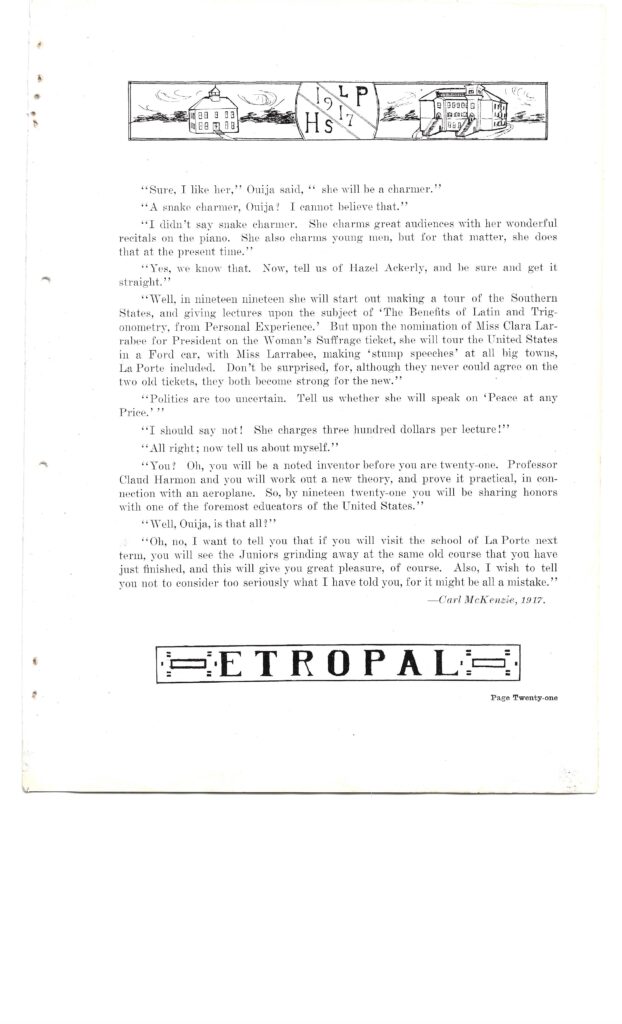
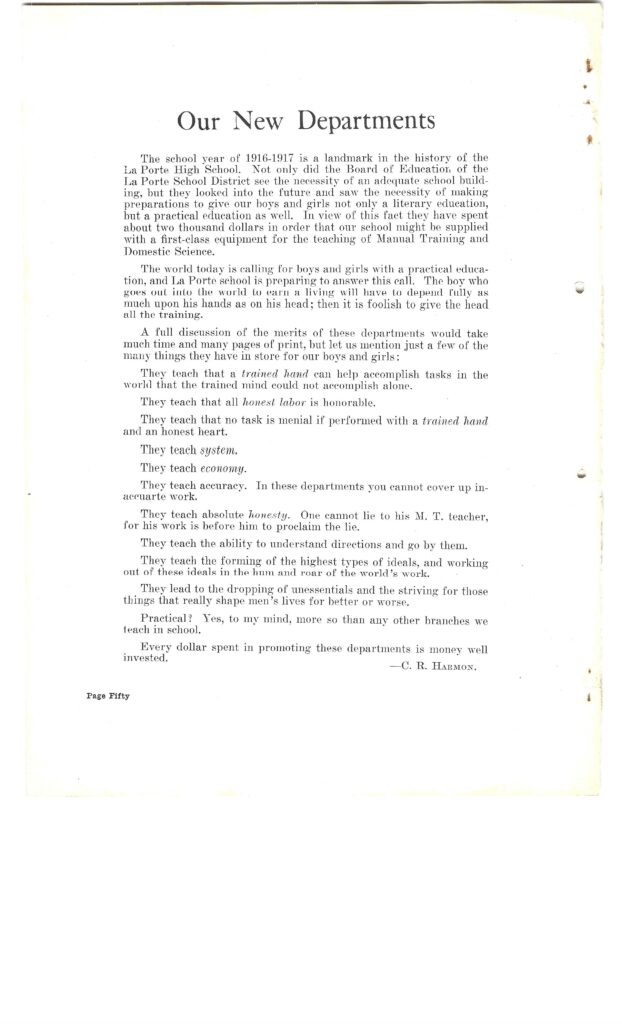
1920 La Porte, Texas
The population of Texas was 4,463,228, and the population of Houston was 138,276. The town of La Porte was 28 years old and had a population of 889. There were 89 Black citizens.
1920s La Porte School District
In the year 1920, La Porte High School organized its first football and basketball teams. The Bulldog was the school mascot, and orange and white were the school colors.


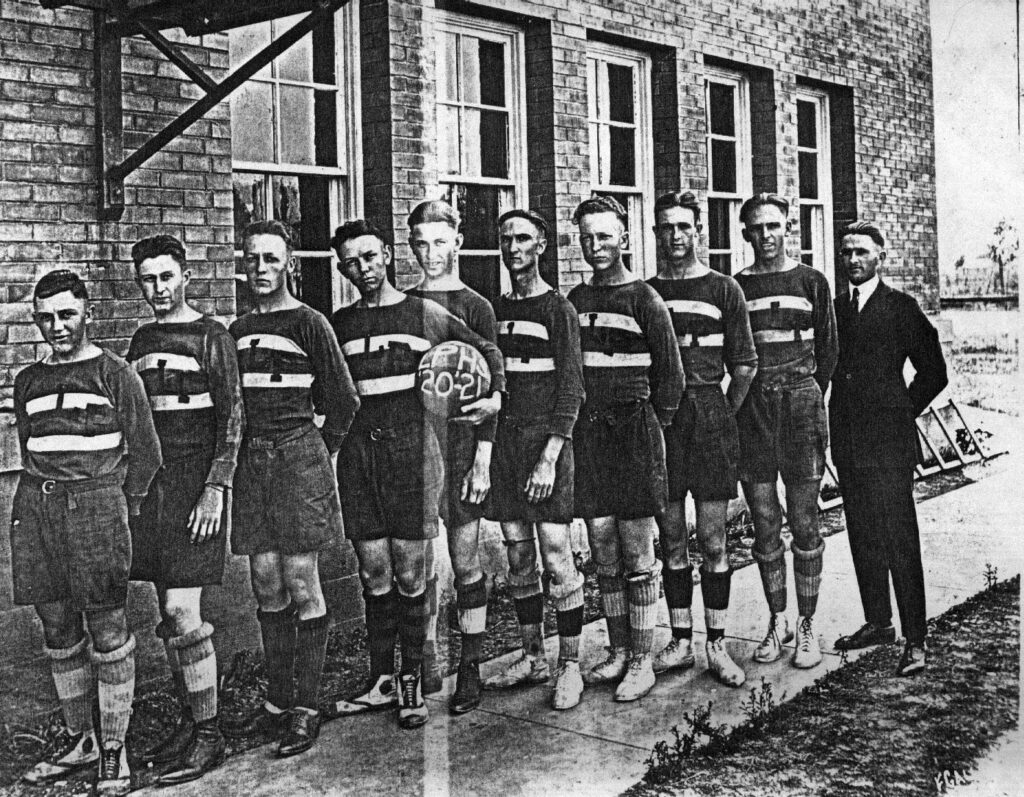
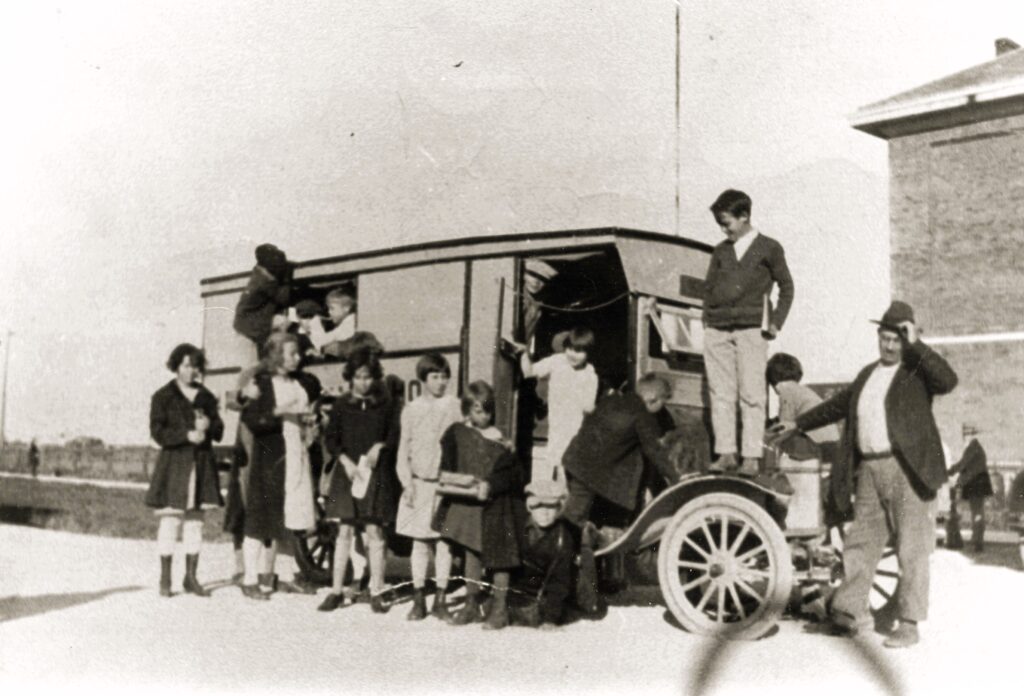
Mr. J.D. Taylor with his custom-made school bus
That same year, the school district received its first school bus, which was built on a Ford chassis by J.D. Taylor.
1921 La Porte Schools’ First PTA
The first Parent Teachers Association (PTA) in La Porte was formed in 1919 when a Mothers’ Club was organized at La Porte Elementary School. Mrs. Theodore Aldrich led the thirty-five members.
In 1921, in response to the growing national movement of parent-teacher associations, the Mothers’ Club was reorganized as the PTA. This change allowed for membership in state and national organizations. Gertrude Ackerly was elected its first president.
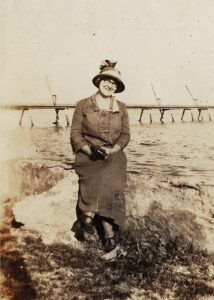
Gertrude Ackerly, First PTA President, at Sylvan Beach Park (circa 1926)
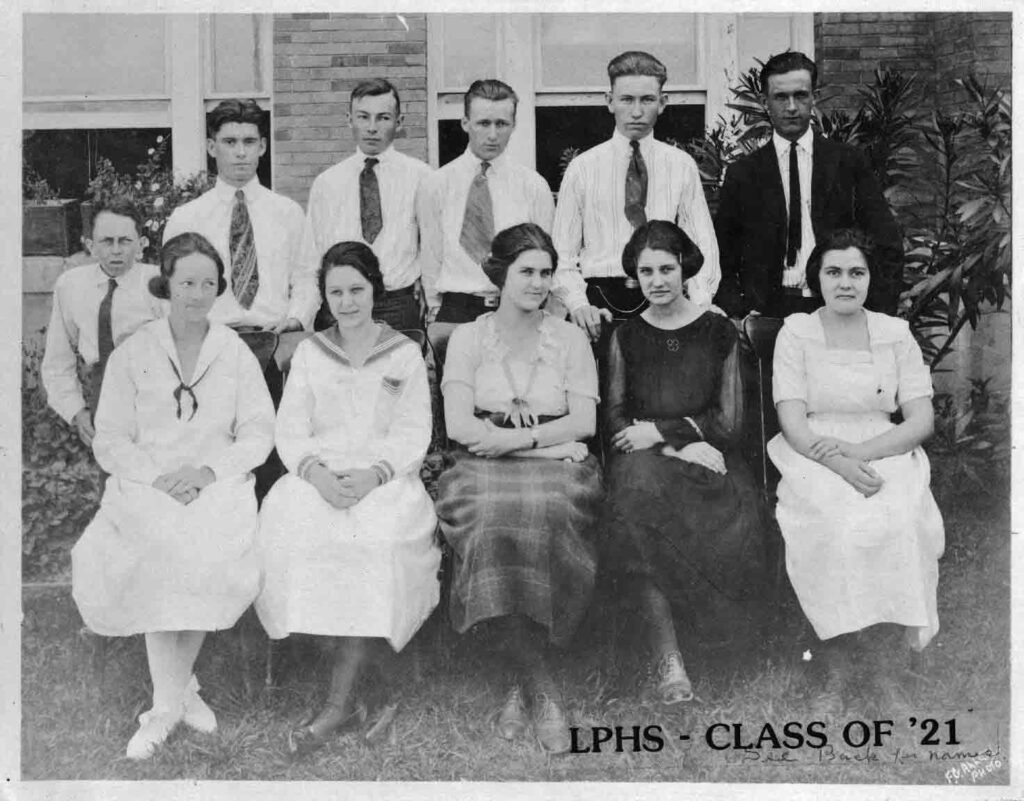
1922 – 1923 La Porte Schools
The school term opened on September 11, 1922. All grades were offered at the high school building south of downtown La Porte. In addition, Lomax School offered first through fourth-grade classes, and Morgan’s Point School provided first through third-grade classes.
The High School built an athletic room with lockers. Additionally, a cooperative supply store, which sold uniforms, paper, pencils, and other school supplies, was built next door. The cooperative was considered convenient for the students and offered the standard materials and supplies they needed at a low cost.
The high school increased its academic program to offer 16 ½ credits, which was 1 ½ credits more than what was required for college entrance. This new educational program included college preparation and gave parents the benefit of not having to pay to send their children elsewhere for their education. Upon graduating, all La Porte High School graduates were ready for college entrance.
As a result of this outstanding curriculum, students from adjacent areas wanted to attend high school at La Porte. Some of those who came were Irving Flowers, a senior and star athlete from Goose Creek who made arrangements to stay at Jim Black’s in Morgan’s Point, Arthur Hill, a fast basketball player also from Goose Creek, as well as several other students from the Seabrook and Lynchburg districts.
The La Porte School District’s monthly tuition for the 1922-1923 school term was $2.50 for the high school, $2.00 for the Sixth and Seventh Grades, $1.75 for the Fourth and Fifth Grades, and $1.50 for First, Second, and Third Grades. Tuition was not collected until the student turned seven.
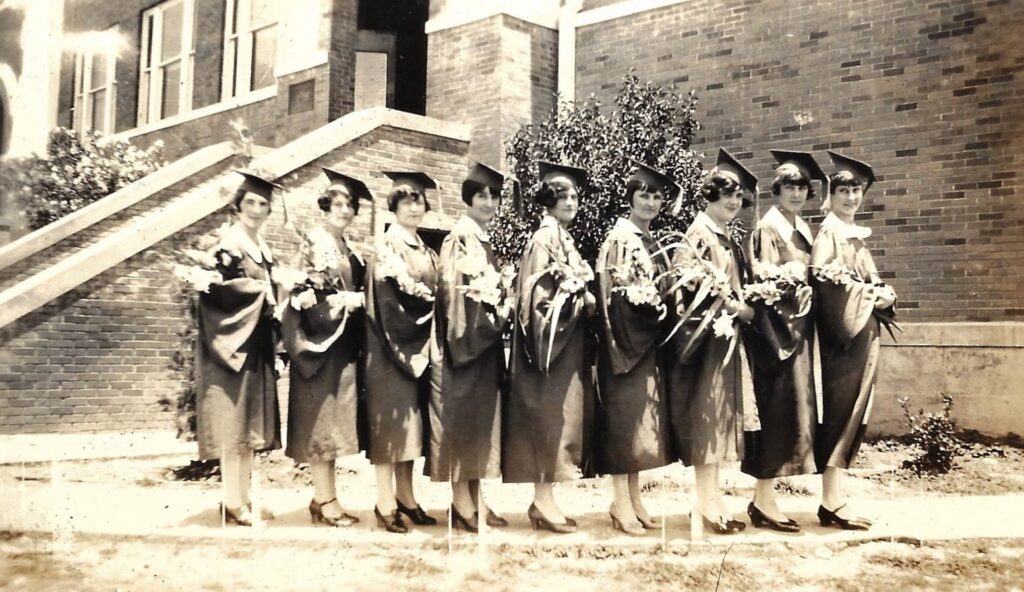
1926 LPHS All-Girl Graduating Class
1925-1926 La Porte Schools
The 1926 graduating class was an all-girl class, and it was also the first year that caps and gowns were worn at the graduation ceremony.
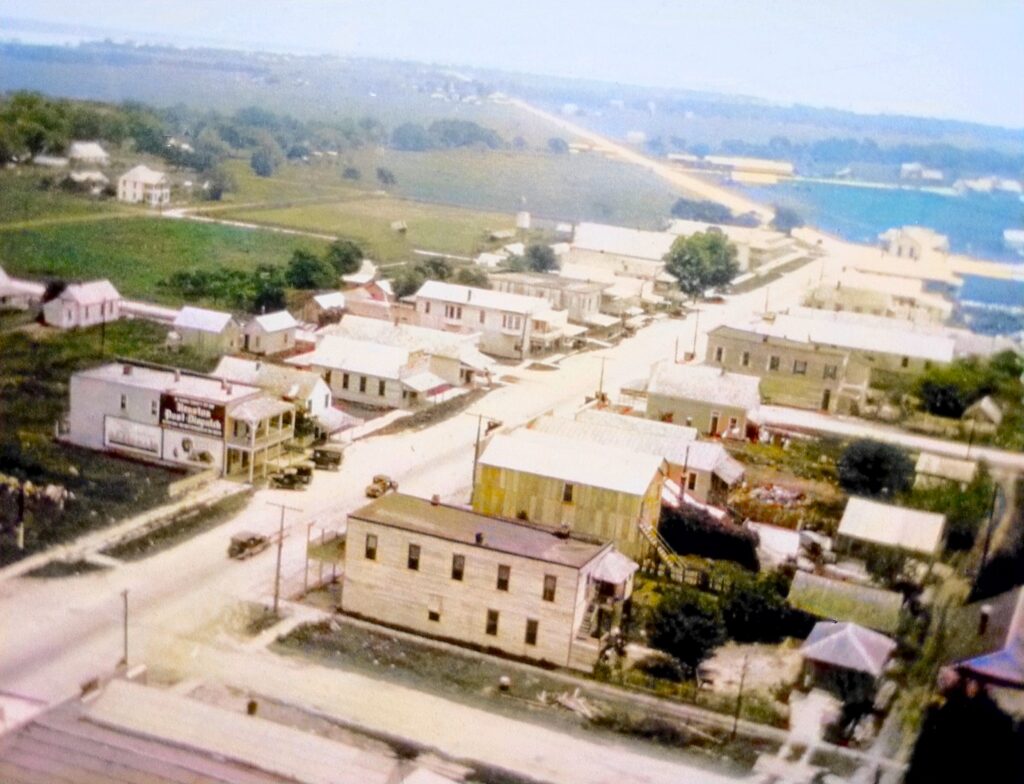
1927 Main Street, La Porte, Texas, Looking to the northeast. (Colorized). Gertrude Ackerly Archives
1928 La Porte Colored School
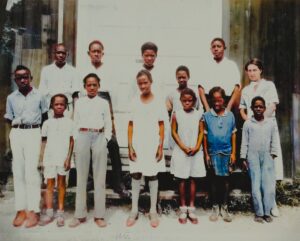
1928 Colored School Class (Colorized) – Back Row v(L-R): Henry Johnson, Fred Watts, Grace Johnson, Evelina Jamison, Spencer Frazier, Viola DeWalt, Teacher. Front Row (L-R): Charles Johnson, Florence Elliott, Frank Elliott, Unknown, Theresa Brown, Martha Lee, Dillard Brown
1930 La Porte, Texas
The population of Texas was 5,824,715, and the population of Houston was 292,352. The town of La Porte was 38 years old and had a population of 1,280. There were 157 Black citizens and 25 students enrolled in the Colored School.
1932 La Porte Schools
The school district constructed a Home Economics building to teach domestic classes. The building was equipped with a kitchen, sewing machines, and worktables, and had a large assembly room and a parlor for the PTA social affairs.
1933 La Porte School District
The La Porte School District’s debt was low in 1933, but the Depression forced a 10% salary cut among the 15 teachers. In 1933, teacher salaries ranged from $810 to $1,377 per year. The teacher for the Colored School, Viola DeWalt, drew $648 per year.
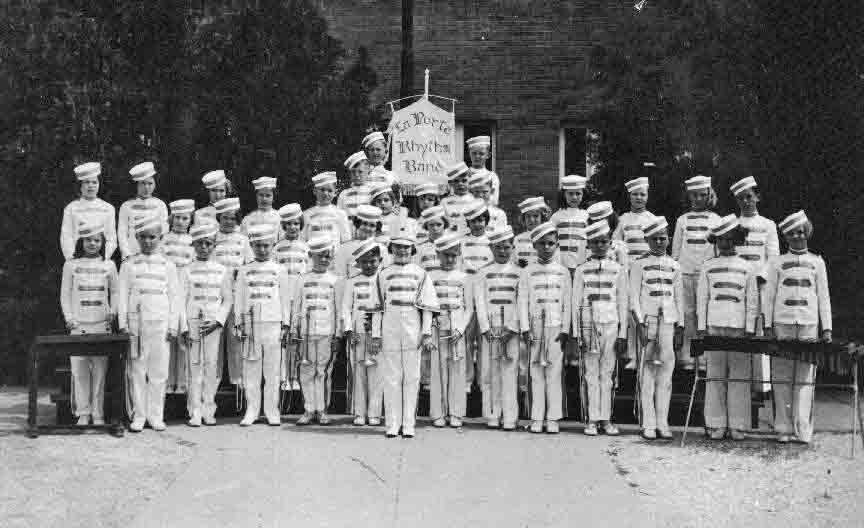
1935 Rhythm Band – Winner of the County Meet. Back row, Left to Right: Dalton Baker, Eugene Lyons(drums). Second row: Shirley Wilson, Dorothy Ann Knighton, Doris Squibb, Louise Goodman, Jack Quinn, Bernice Browning, Gwyneth Duane, Dorothy Jean McClure, Robert Cardiff, David Vanguard, Mary Sue Aves, Helen Childress, Jane Isensee, Harry Witek. Third row: Pauline Stevenson, Frances Coleman, Jean Williams, Gladys Hovey, Mildred Lyons, Lillian Hill, Norma Ruth Linkhart, Eleanor Simon. Fourth row: Joanna Miller, Chester Dennis, Ivan Shore, A.T. Moore, Dickey Harrison, Pat Carter, Wesley Hovey, Herbert Simon, John Shelor. Leader, Emily Brown, center front.
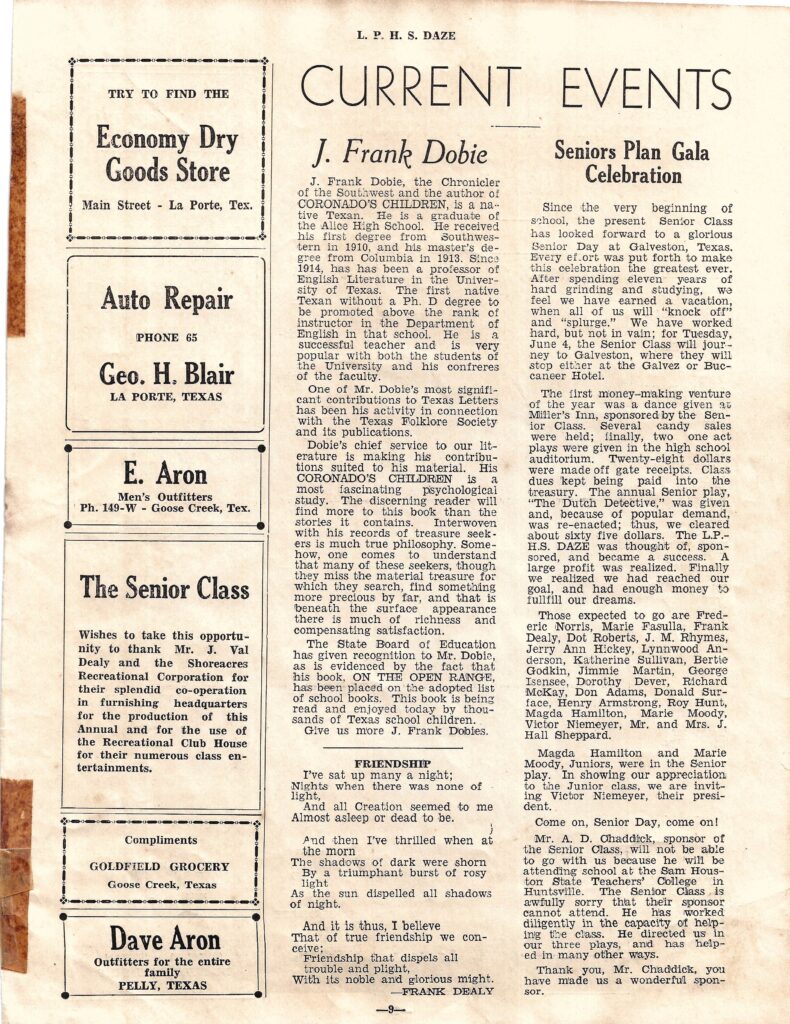
L.P.H.S. DAZE, the 1935 Yearbook
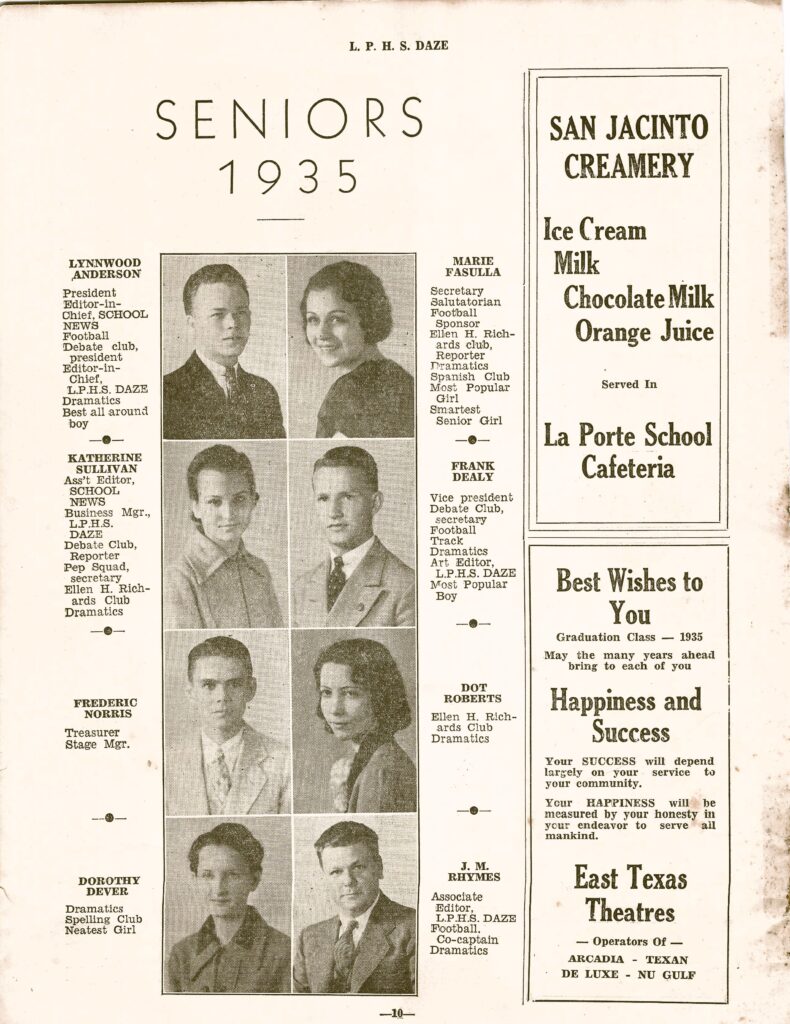

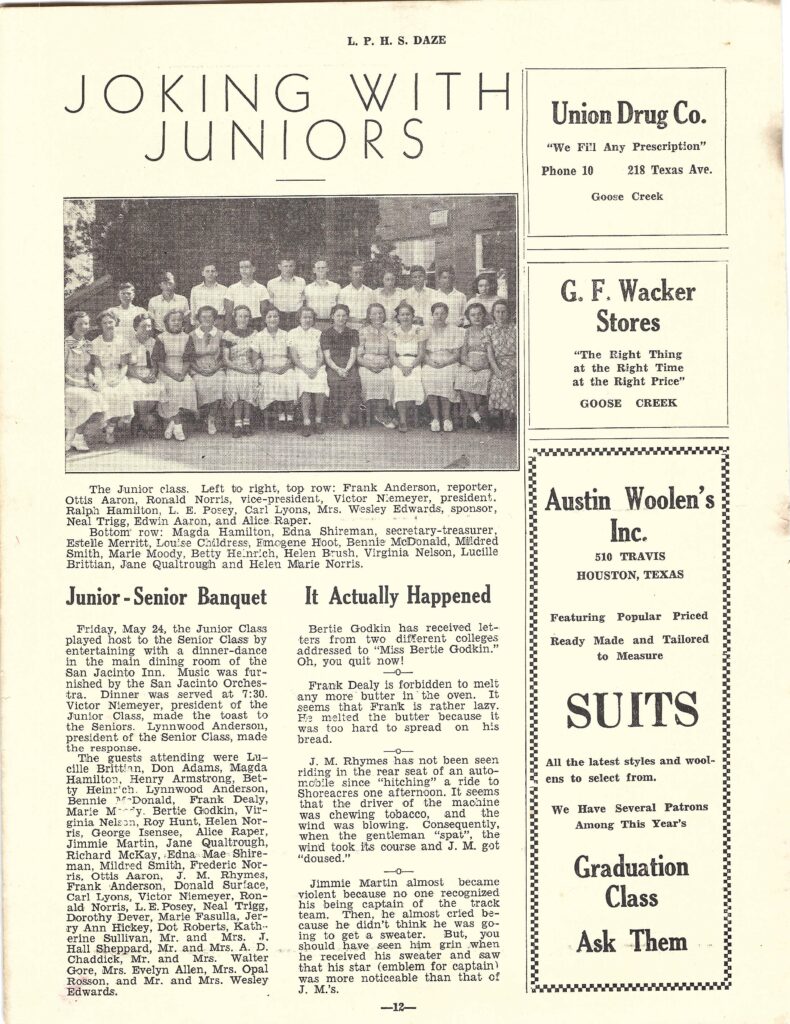
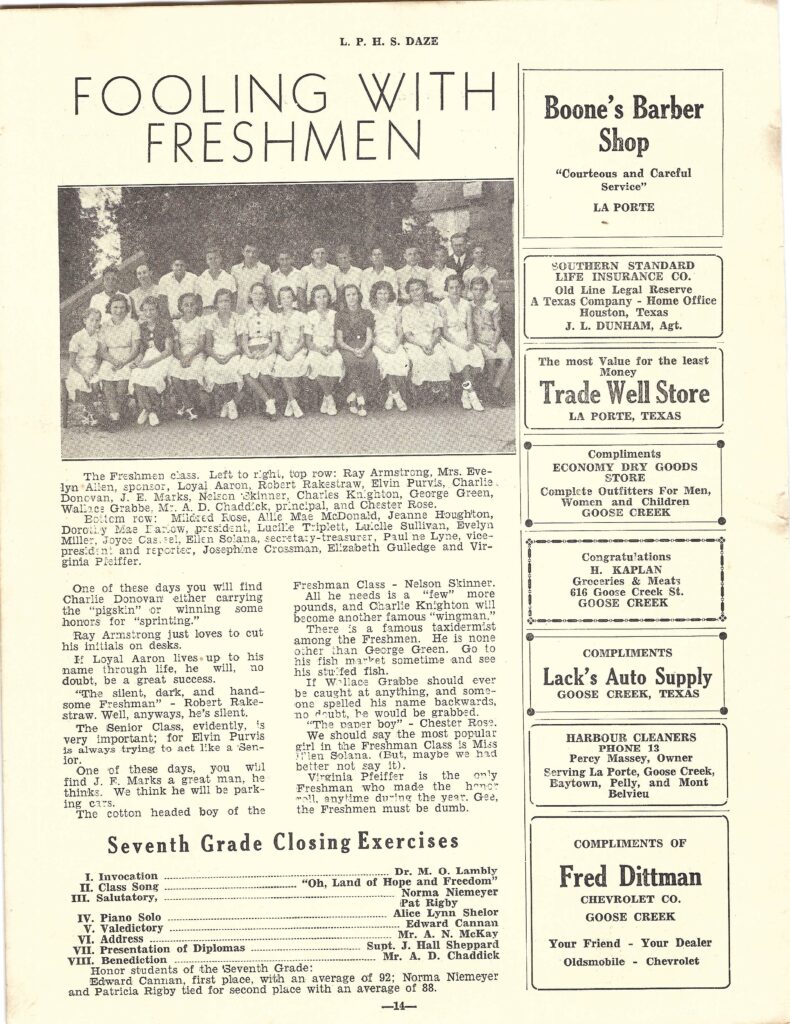
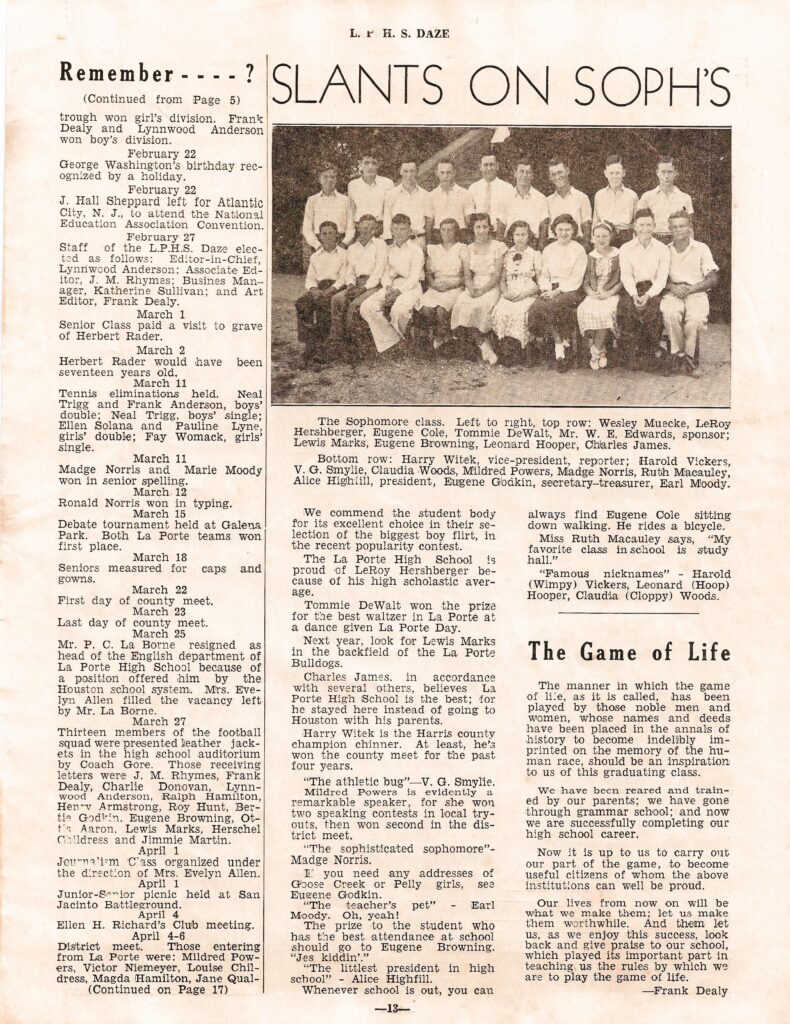
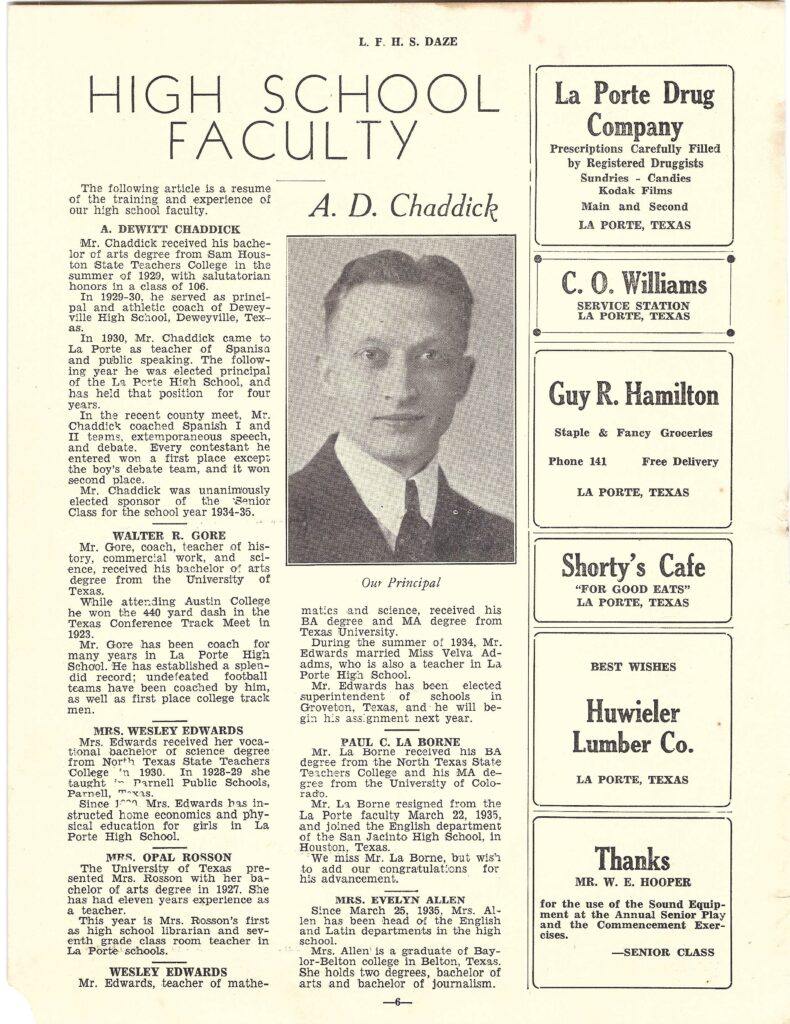
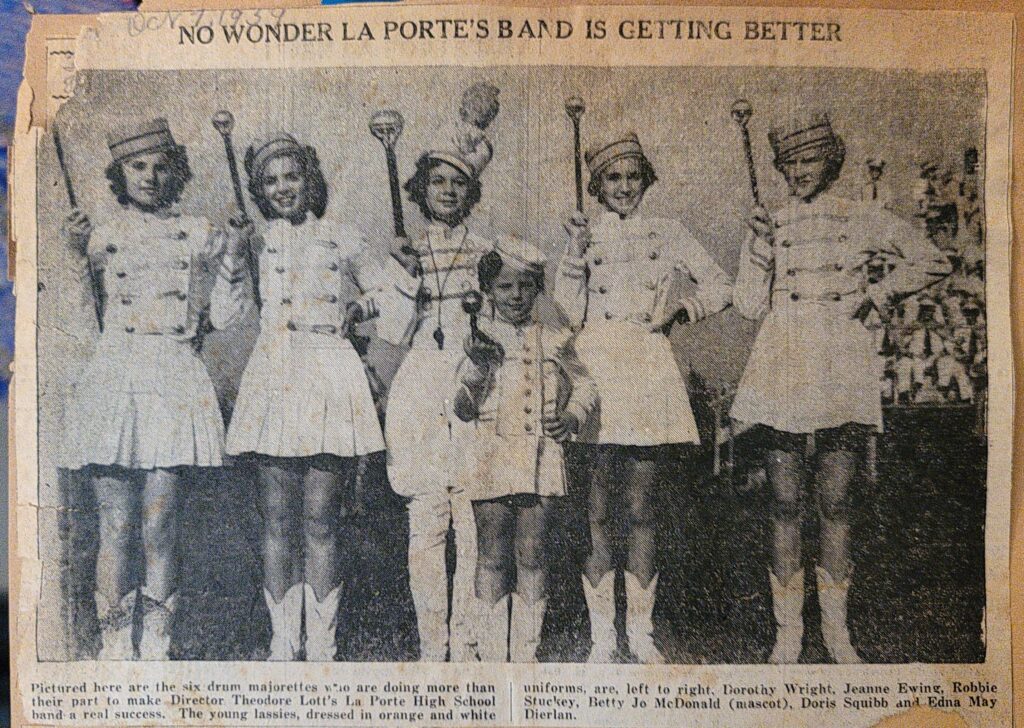
1937 La Porte School District Grows
The year 1937 saw the La Porte School District continue to grow. After more than a two-year delay, on November 1, 1937, ground was broken, and the cornerstone was laid for the new Gymnasium. Following this significant expansion, a new elementary school for First through Sixth Grade was constructed on Broadway South of the Gymnasium. In addition to these new facilities, around this same time, both the Morgan’s Point School and the Lomax School buildings were moved to the east side of the main campus on “C” Street and Broadway. Notably, the two-room Morgan’s Point building served as elementary classrooms and later became the band hall.
The new La Porte Elementary School opened for the Fall semester of 1938. The school had seventeen rooms and opened with fifteen teachers.
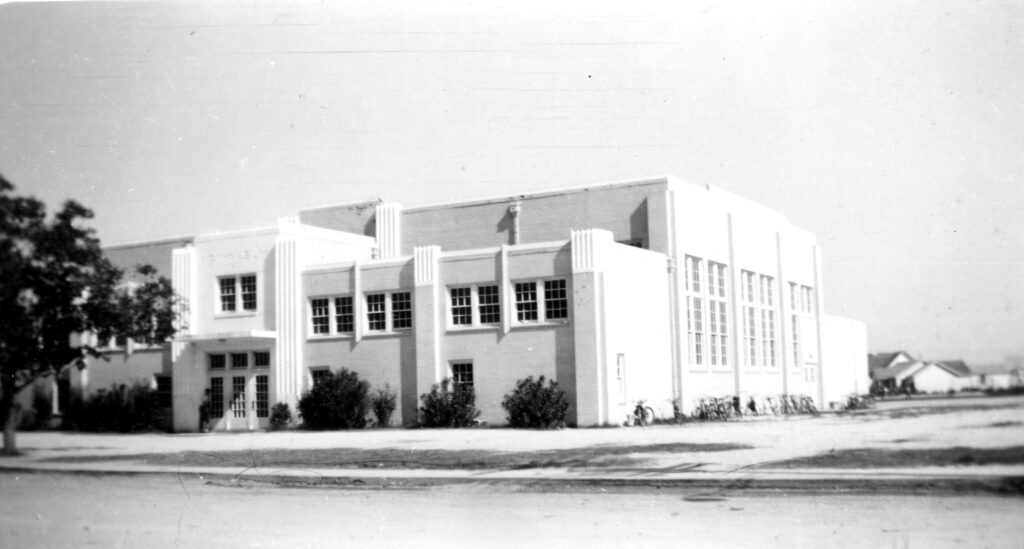
1938 – Elementary School (above) and Gymnasium (below)
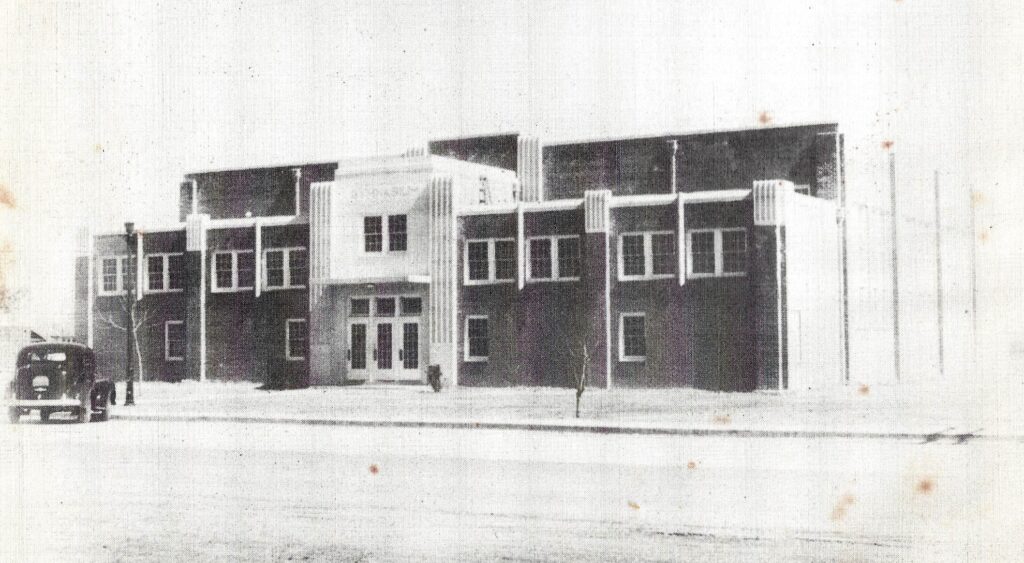
The population of Texas was 6,414,824, and the population of Houston was 384,514. The town of La Porte was 48 years old, with a population of 3,072, which had more than doubled since 1930. There were 268 Black citizens, and approximately 45 students enrolled in the Colored School.
1940 La Porte Schools
More classrooms were needed as the student enrollment continued to grow. Since the new Gymnasium was outfitted as an auditorium, the 500-seat auditorium at the high school building was no longer needed. The auditorium was converted into four classrooms, and the school cafeteria was relocated to the first floor.
1943 “New” Two-Room Colored School
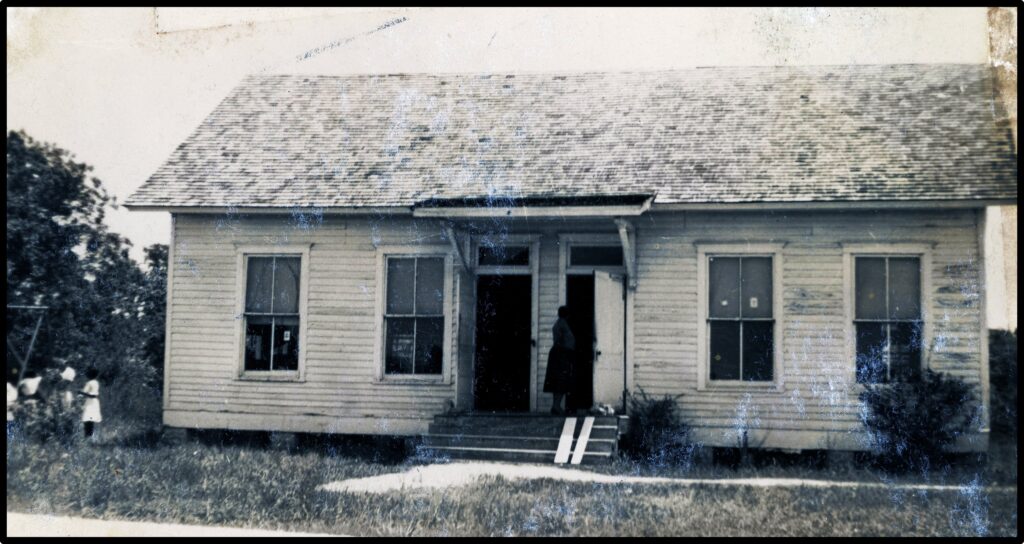
1943 New Colored School Building
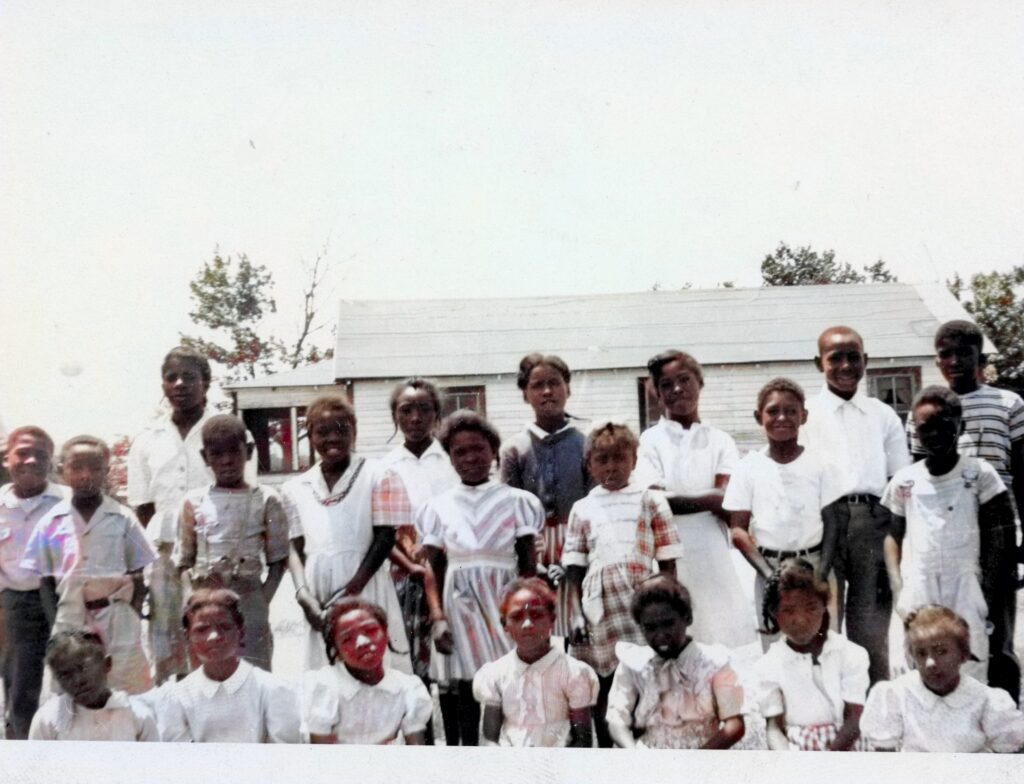
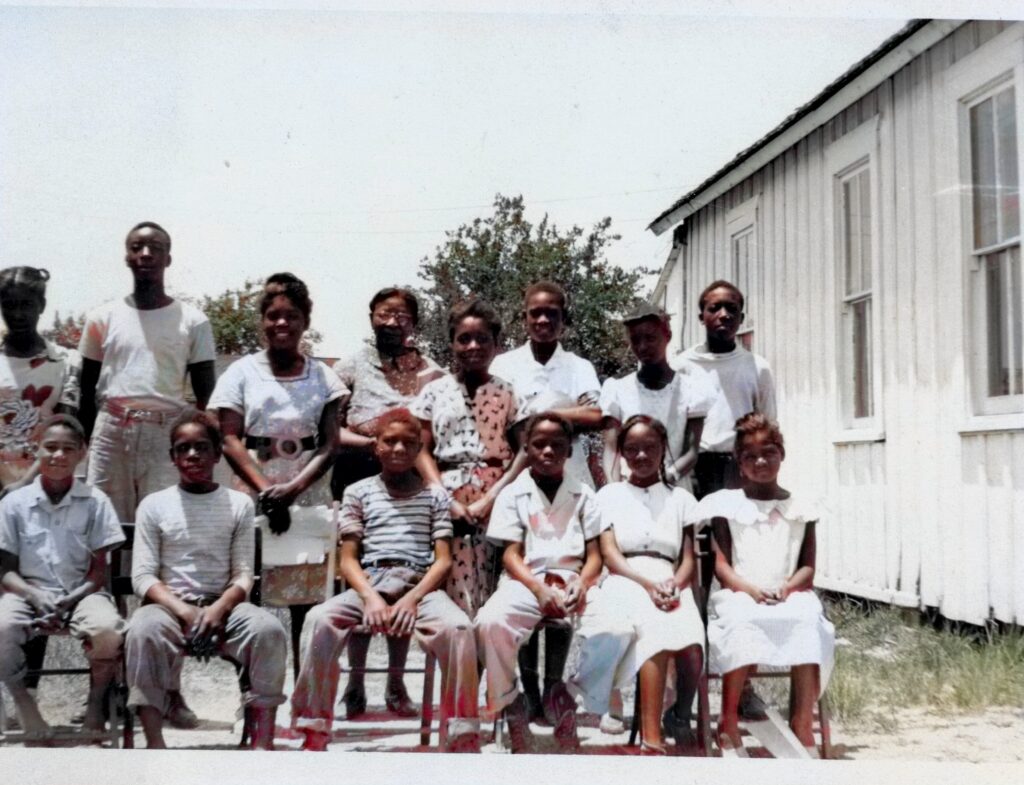

La Porte Colored School Class Photo, colorized. (circa 1944)
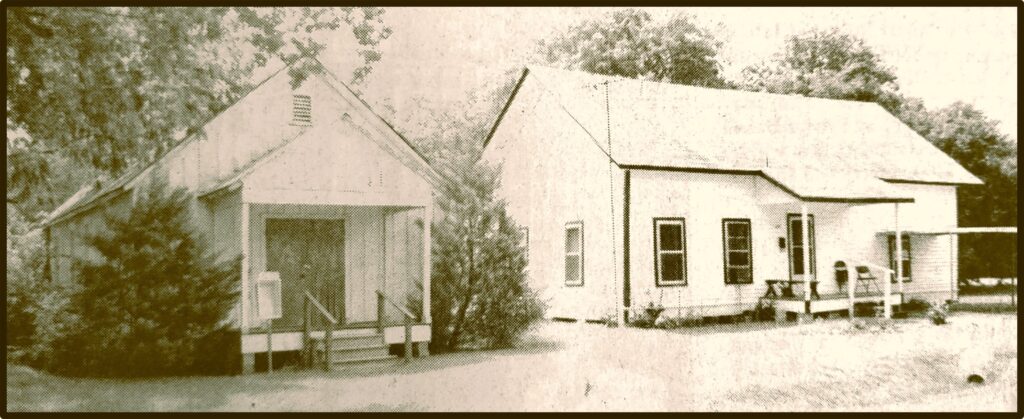
Viola DeWalt (63) retired after 32 years as the teacher for La Porte’s Colored School. During that time, she taught generations of families in addition to her daughter, Maretta, and two granddaughters, LaRetta and Theresa. At the time, she was the longest tenured teacher in La Porte.
Viola’s retirement coincided with her oldest granddaughter’s graduation from 8th grade. Since there was no colored school in La Porte for higher education, Viola and her granddaughters moved to Third Ward, in Houston, where the girls attended Yates High School.
That same year, the former Morgan’s Point schoolhouse that had served as a classroom and band hall on the main school campus since 1939 was moved to the north side of town next to the original one-room Colored School. The two-room building was painted and repaired and served as the new Colored School for the 1943-1944 school year. This two-room school served the Black children in the community for the next ten years.
1943 Surprise Hurricane
In the days of World War II, the ships at sea and in the Gulf of Mexico were under strict radio silence. Notifying the coastal towns of the ominous weather conditions was prohibited. Without any warning, the towns along the Gulf Coast were unaware of the severity of the storm headed their way. On July 27, 1943, from midafternoon through early evening, the Bay area communities, from Kemah and Seabrook to the South through La Porte and Baytown to the north, took a direct hit from the storm as it moved inland from Galveston Bay.
With winds estimated above 70-80 mph, no building or house in La Porte was left untouched. The hurricane hit La Porte, first destroying Sylvan Beach Park, then headed north toward Main Street, damaging several homes and buildings in its path. One of the buildings hardest hit was the 3-story brick high school building on Broadway. The roof and top two floors of the school were severely damaged, rendering it unusable for the coming school year.
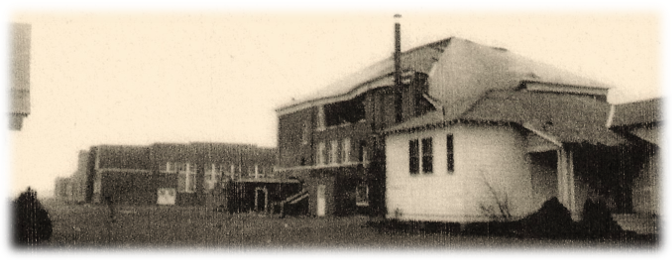
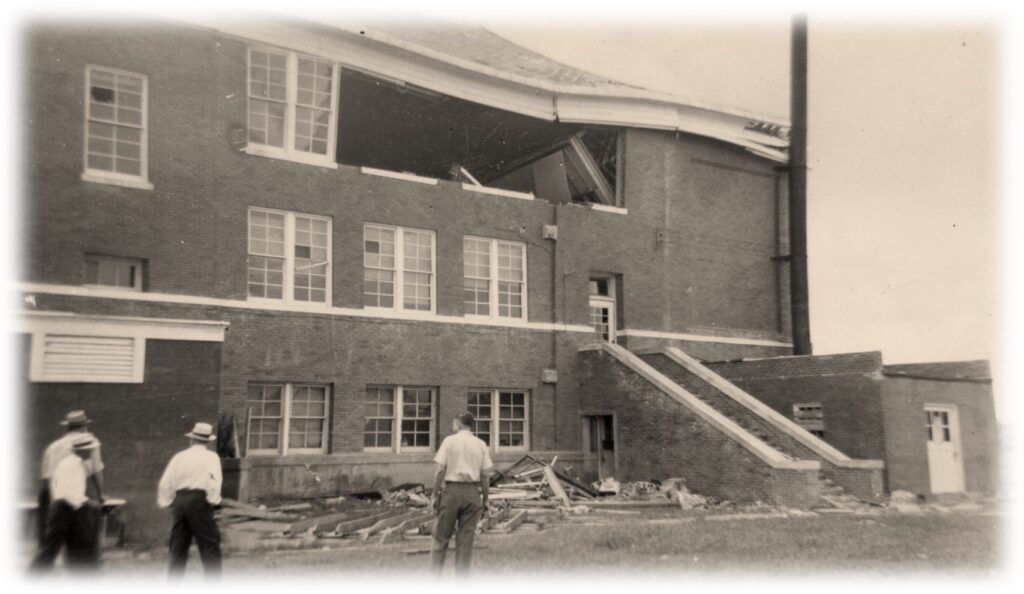
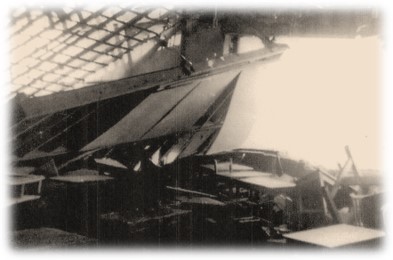
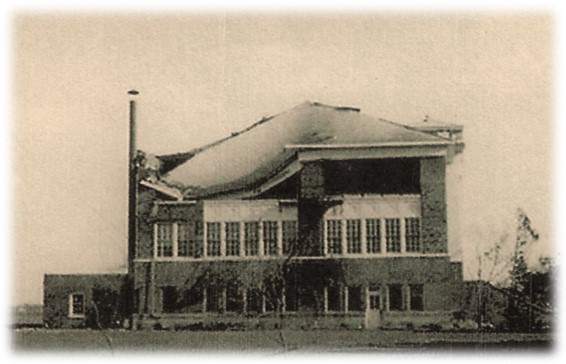
1943 Surprise Hurricane severely damaged the 3-story brick schoolhouse.
1943-1944 The School District Adapts
The three-story school was deemed uninhabitable for the 1943-1944 term. The School trustees were forced to find alternative classrooms to make up for the fifteen classrooms put out of commission. Due to the limited availability of space, class times were divided into half days. Primary school students attended in the morning, while high school students attended in the afternoon. The Gymnasium and any other available areas were converted into classrooms. As a result, since the students were only attending half days, the cafeteria was closed for the school year.
The teachers were overworked; in fact, many were on double duty until 1945. The shortage of teachers caused by World War II had depleted the availability of young men and women teachers. Consequently, many were serving in the military as nurses and soldiers.
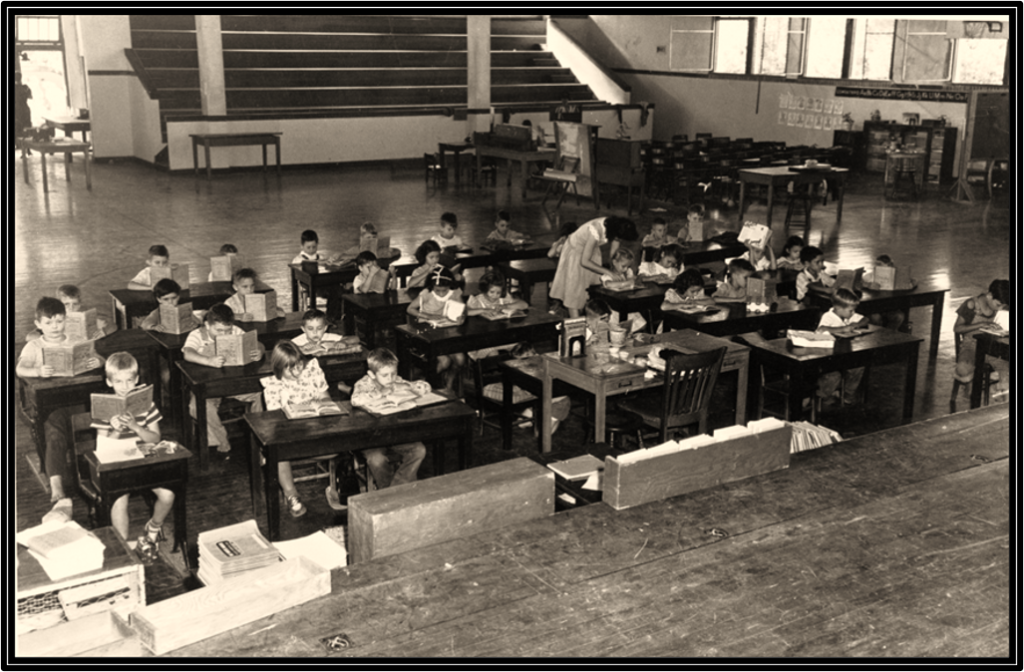
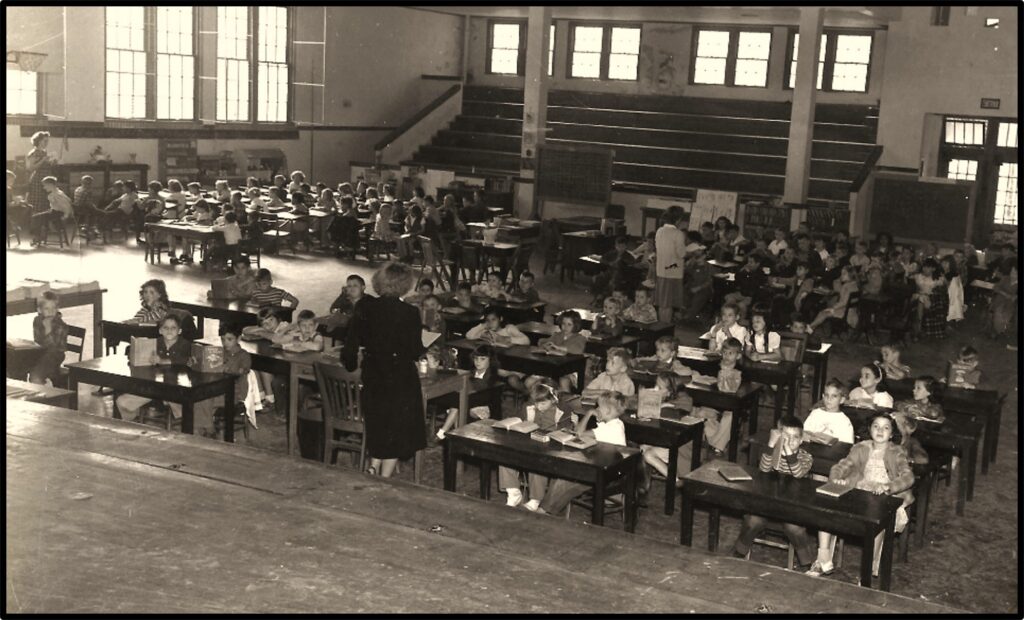
The Gymnasium served as classrooms. Following the 1943 Hurricane, every available space served as a classroom.
1945 La Porte School District
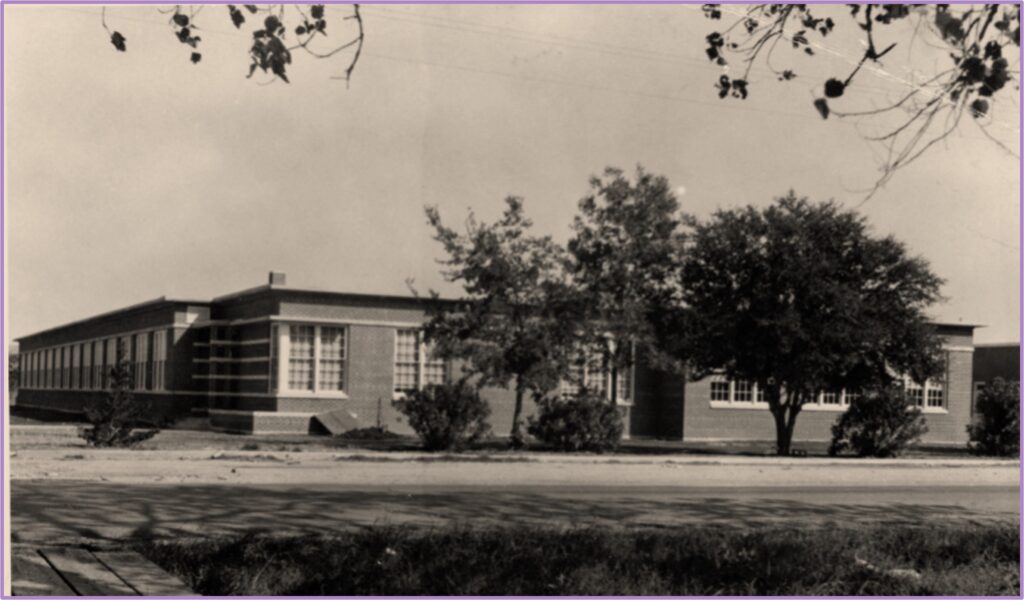
The 1945-1946 school term opened on September 10, 1945, with an enrollment of 768 students for both the elementary and high school. The 1943 hurricane damaged the top two floors of the 3-story brick building to such an extent that only the first floor was repaired and completed for the opening of the Fall term.
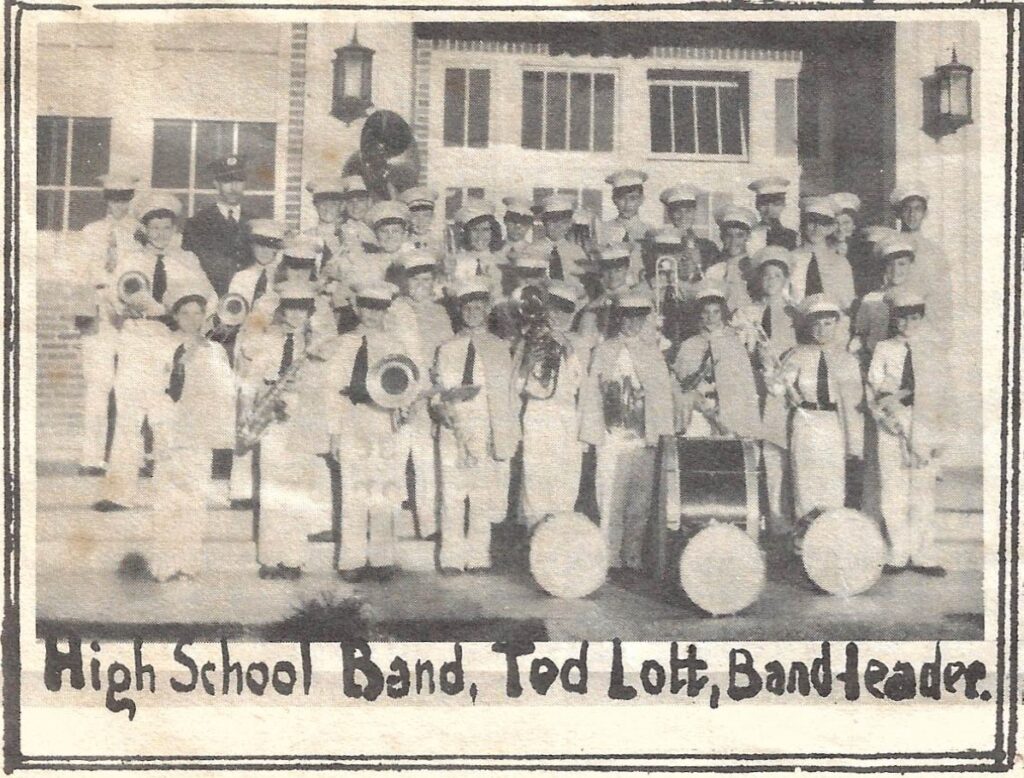
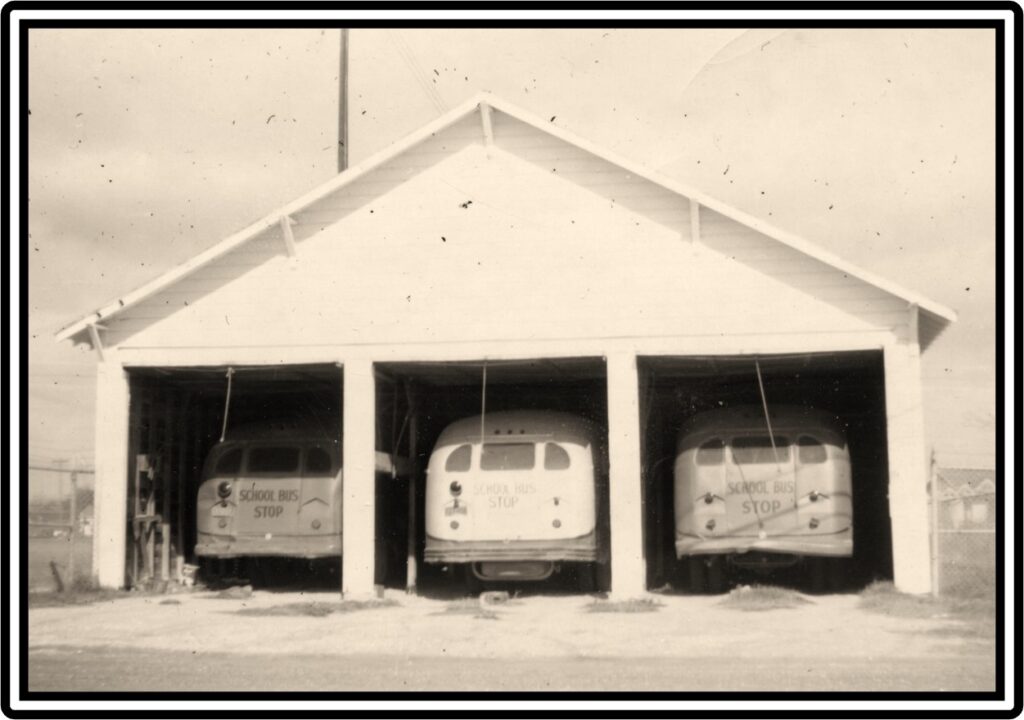
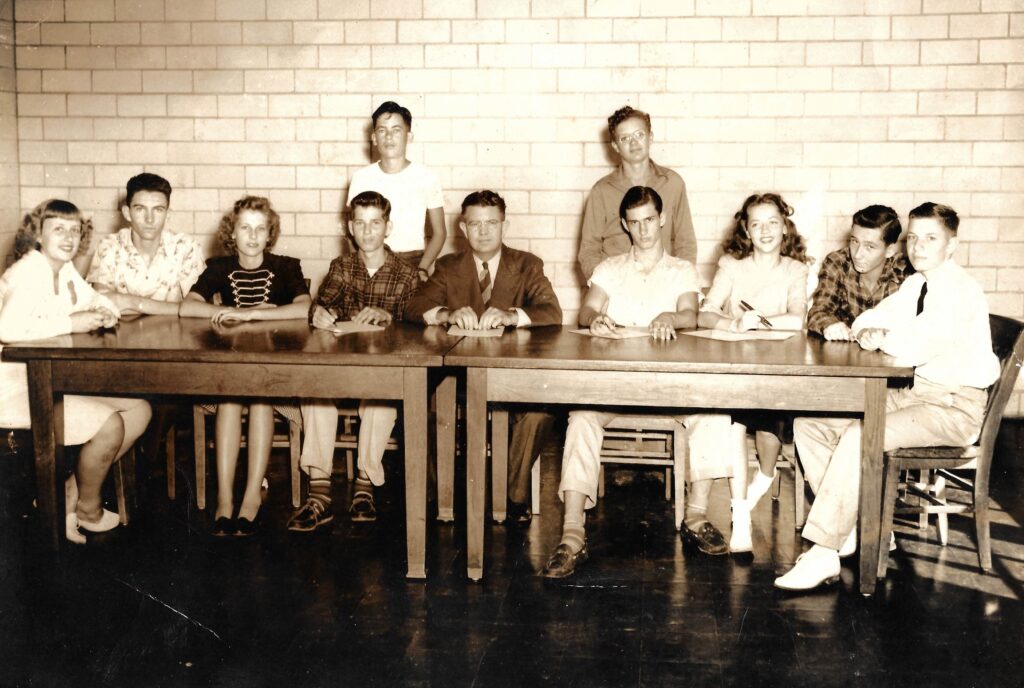
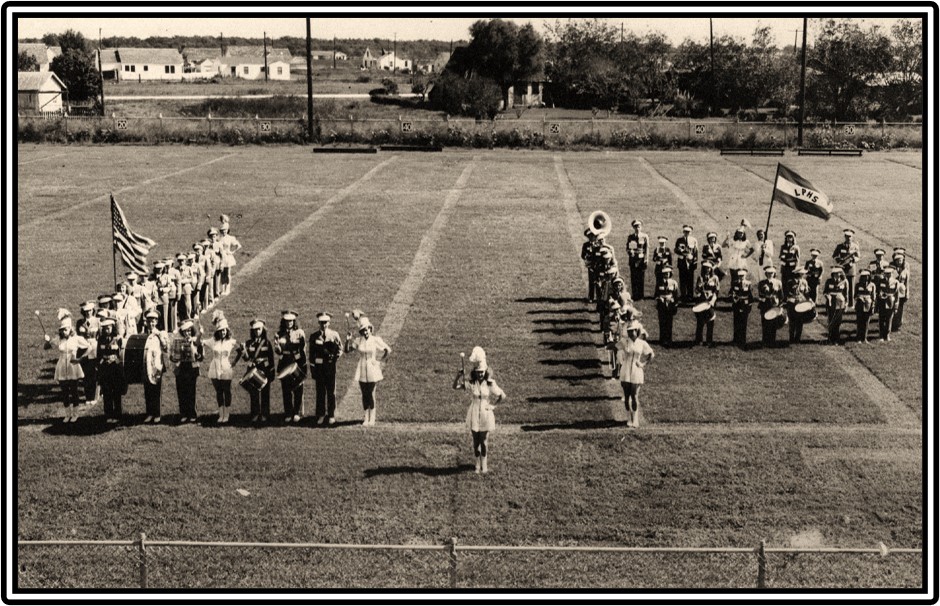
1947 La Porte Colored School Accreditation
The Colored School passed the Texas State Education Accreditation in 1947 and officially became part of the La Porte School District with a nine-month curriculum.
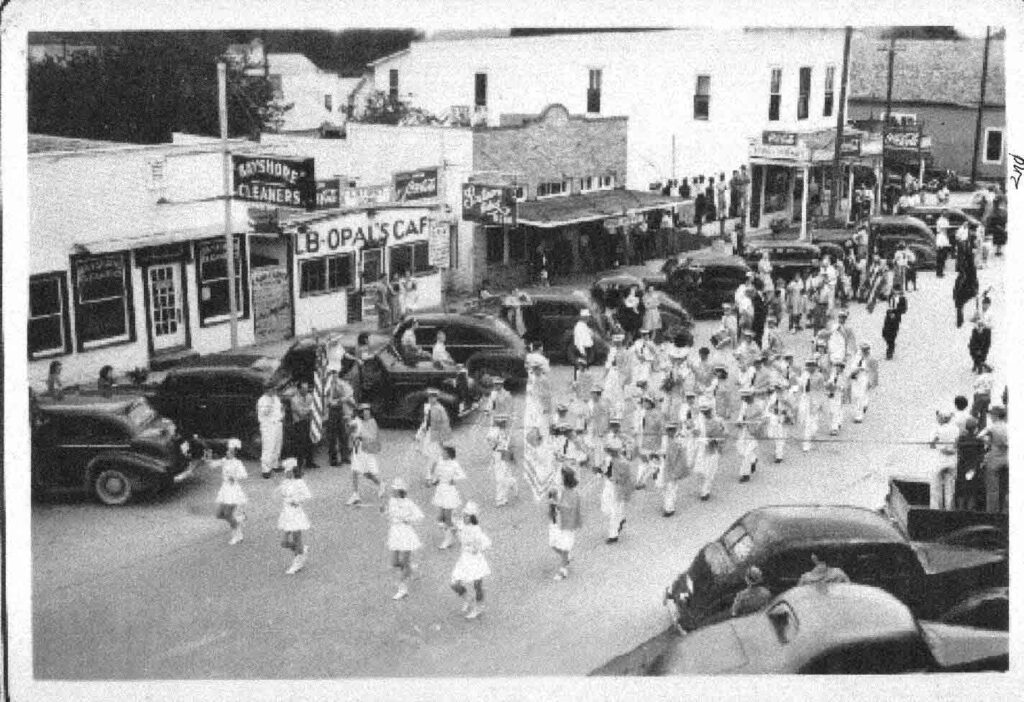
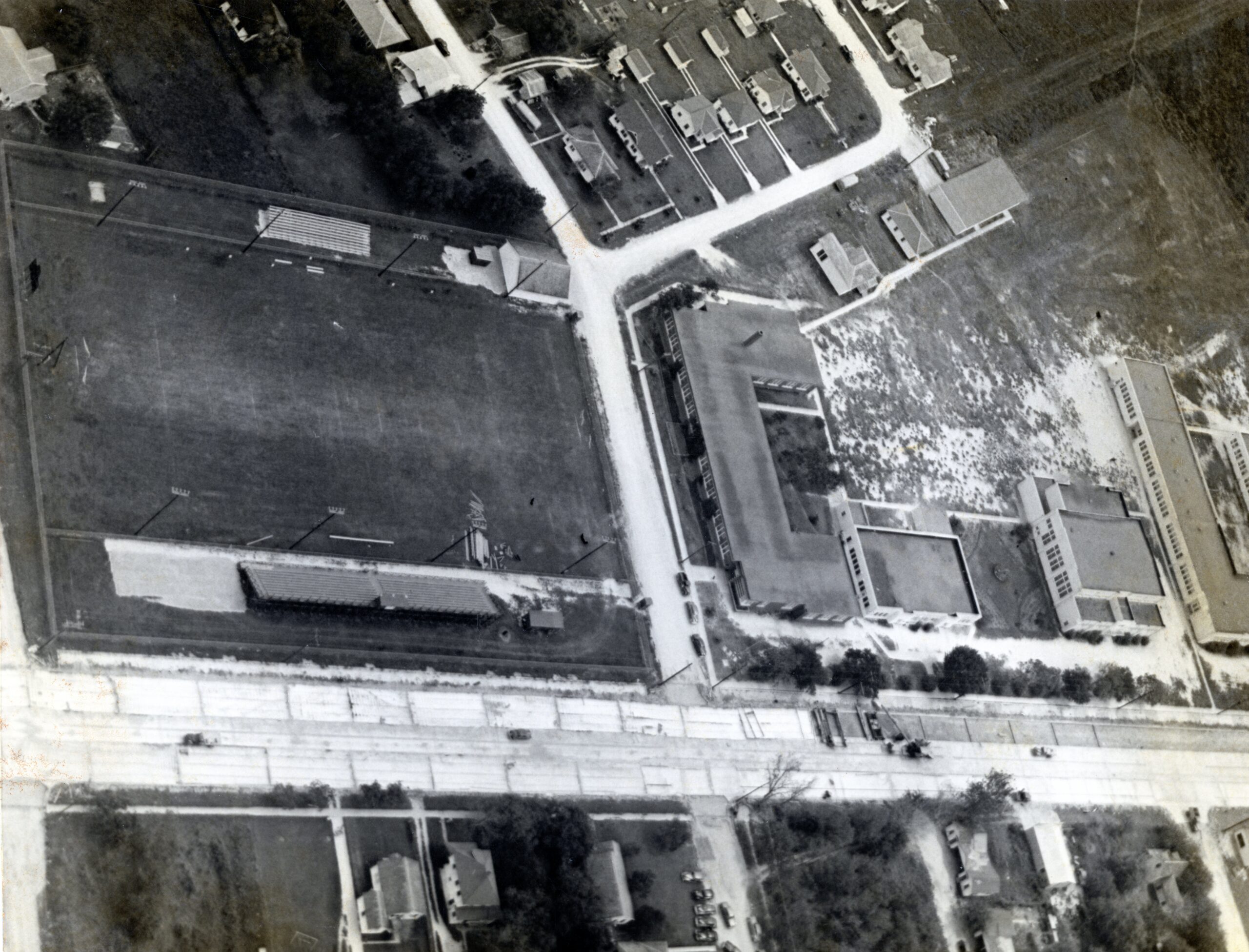
1950 La Porte school campus on Broadway. Football stadium on the left, high school to the right.
1950 La Porte, Texas
The population of Texas was 7,672,432, and the population of Houston was 596,163. The town of La Porte was 58 years old and had a population of 4,429.
1950-1960 La Porte, Texas
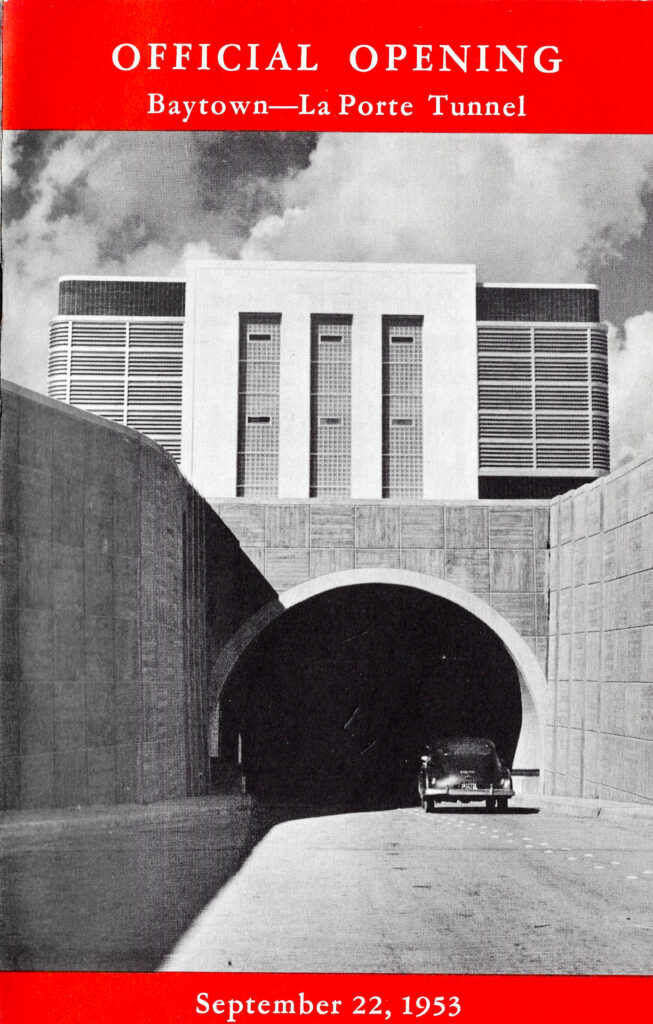
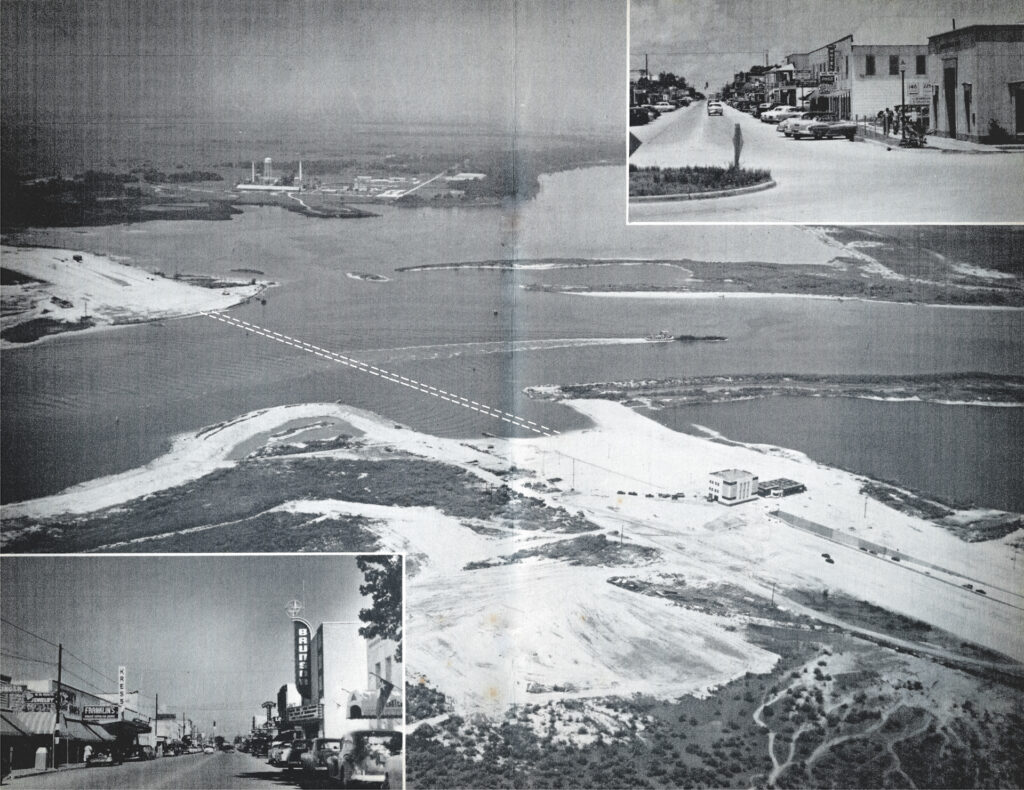
The world was changing, and so was La Porte. The opening of the Baytown-La Porte Tunnel in 1953 created a vital link in travel along the Texas Gulf Coast, bringing the eastern and northern sections of the country closer to South Texas and Mexico.
1953 Viola DeWalt School Opens

The La Porte Liberal, 1952

The La Porte Liberal, June 26, 1953
In the Spring of 1953, La Porte School District approved plans to construct a new school for the Black children of La Porte. The construction contract for the new school was awarded on April 30, 1953. The building, located on North “D” Street, which covered 4,500 square feet, included a 25 ft. x 50 ft. classroom, an auditorium (that could be converted into two classrooms by an accordion partition), a 25 ft. x 25 ft. classroom, a 25 ft. x 14 ft. stage, a principal’s office, a reception room, restrooms, a utility room for housing janitorial supplies, and a book room. The school, named after longtime teacher Viola DeWalt, opened in the fall of 1953.
A few months after the DeWalt School opened, the U.S. Supreme Court was preparing to hear Brown v. Board of Education of Topeka. On May 17, 1954, the Supreme Court issued a unanimous ruling that declared state laws establishing separate public schools for Black and White students unconstitutional, effectively and decisively overturning the “separate but equal” doctrine.
The La Porte School trustees rested easy, however. After all, they had built a state-of-the-art, air-conditioned Colored School of higher quality than any of the White schools in its District. They had separate but better.
La Porte took immense pride in its schools and teaching staff. Of the fifty-three faculty members, 23 held master’s degrees, and the total teaching experience of the faculty numbered 582 years, or an average of 11 years per teacher. La Porte teachers’ annual salary for bachelor’s degree teachers with no experience was $2,800.
Enrollment for 1953-1954 surpassed the estimated 1,500, for a total of 1,650, which included 67 Black students.
1959 New La Porte High School
The new La Porte High School, located on the north side of “J” Street, now Fairmont Parkway, east of Broadway, opened for classes in the Fall of 1959.
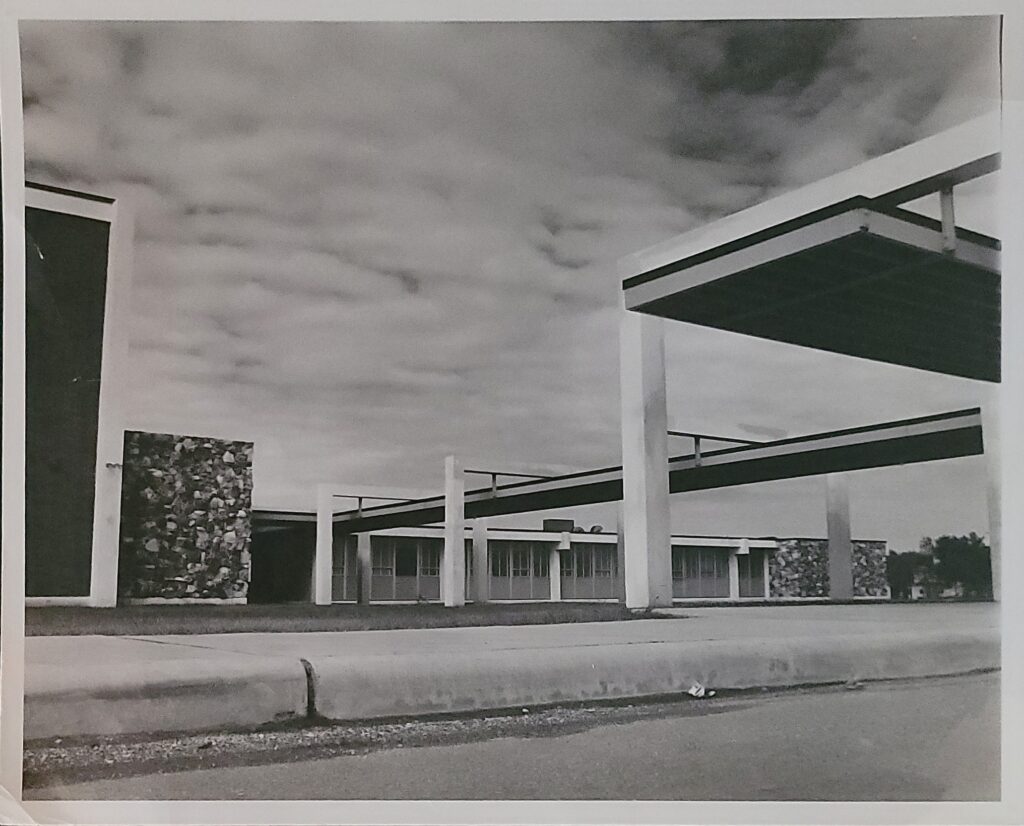
La Porte High School (circa 1960)
1960 La Porte, Texas
The population of Texas was 9,579,667, and the population of Houston was 938,219. The town of La Porte was 68 years old and had a population of 4,512.
The civil rights movement gained momentum in the 1960s and slowly making its way across the southern United States. By 1963, President John F. Kennedy had defined the movement as “moral as well as constitutional and legal” and announced that primary civil rights legislation would be sent to Congress “to guarantee equal access to public facilities, end segregation in education, and provide federal protection of the right to vote.”
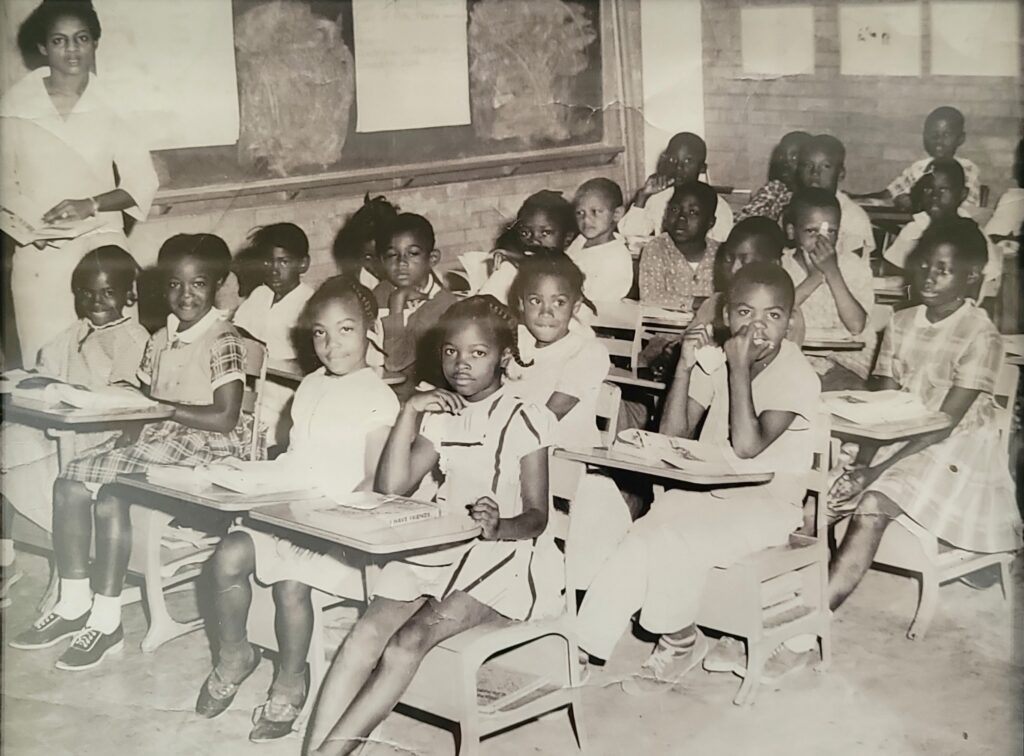
1960-61 DeWalt Elementary. Teacher Mary Gay
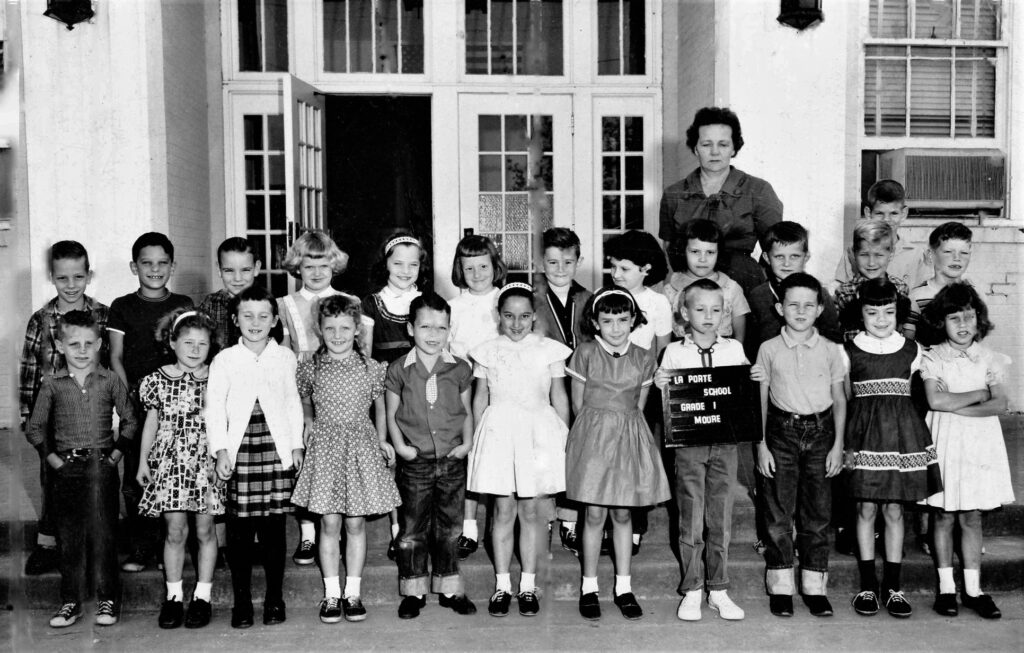
1961-62 La Porte Elementary School, First Grade Class. Teacher Mrs. Moore
1962-1963 La Porte Schools
In 1962, La Porte citizens passed a bond for school expansion projects. As part of that expansion, Baker Elementary School opened to serve the children of the Fairmont Park and Lomax areas, a cafetorium and library building were added for the primary and intermediate schools on Broadway, and an addition was added to the DeWalt School.

Baker Elementary School on Fairmont Parkway at Underwood opened 1963
1963-1964 La Porte Schools Integrate
The Civil Rights movement continued the push for school integration across the United States. Still, the movement in the South was slow. In La Porte, Texas, the applications of five Black students to attend the all-White La Porte High School just weeks before the start of the 1963 Fall term prompted the La Porte School Board to act quickly. Following emergency board meetings and discussions among the trustees and citizens, an integration policy was implemented only days before the 1963-1964 school year started.
This is a problem that has been facing us for some time. It is one that we have realized we must face within the near future. I feel that this could better be solved by our own people within our community rather than let outside demonstrators and agitators take over.”
— Preston Head, President La Porte School Board
The Policy
The integration policy set by the school board allowed integration at the high school and junior high levels, giving students the choice to attend the La Porte Schools or the all-black George Washington Carver High School in Baytown. Since there were three elementary schools at the primary level, geographical “zones” were established for attendance. Zones were outlined for La Porte’s main campus on Broadway, DeWalt Elementary on the north side, and Baker Elementary west of town.
The policy provided that students in these zones would attend the designated school. A transfer from one zone to another would be accepted only if parents making the request desired their children to attend a school predominantly of their race. Simply put, under this policy, a white student living in the DeWalt zone could attend the school in the adjoining zone. Likewise, a black student living in one of the white zones could transfer to DeWalt.
The policy also stated that requests for transfers to other school districts to attend a school of predominantly the same race may be approved, even though the transfer of local funds was involved. Requests for transfers to other districts would be approved, provided no transfer of funds was involved. Requests for transfers into the La Porte School District would be approved or disapproved for cause.
“I think the Board has established a fair policy and they have taken into full consideration the best interest of the students concerned. And, indications are that it will work very well.”
–Ralph Pearce, La Porte School District Superintendent
Student-Athlete Eligibility
Because of this new integration policy, the question of Black student-athlete eligibility needed to be addressed, as well. According to Rhea Williams, who was director of the Texas Interscholastic League, “As long as a student has a choice between two schools and has participated in one of the schools previously, he would not be eligible to participate without staying out one year.” Of course, what this meant was that Black athletes who participated at Carver would not be able to participate at La Porte during their first year because they had the choice of schools. If they had been forced to attend La Porte High School, then they would have been automatically eligible.
Baytown School Board’s Reacts
In response to La Porte’s policy, the Baytown School Board called a special meeting and voted to charge the La Porte School District $200 for tuition per Black student from La Porte attending George Washington Carver High School in Baytown.
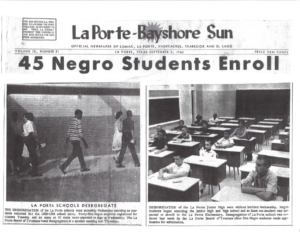
First Day of Desegration
On September 5, 1963, the schools of the La Porte Independent School District were desegregated. On the first day of school, 45 Black students registered to attend the high school and junior high, with more expected. Of the 45 Black students enrolled to attend La Porte’s all-White schools, 29 enrolled at the high school and 16 at the junior high. The day was peaceful, and no incidents were reported.
“I believe delaying the integration of our schools would serve no good purpose. We have had time to prepare and work out what we feel will be a fair and realistic plan for all of our patrons, and now it is our moral and civic duty to pull it into effect.”
— Mrs. Marjorie Warren, Member of the Black Community
Civil Rights Act of 1964
The Civil Rights Act of 1964, signed into law by President Lyndon B. Johnson on July 2, 1964, was considered the most comprehensive Civil Rights legislation since Reconstruction. The Act prohibited discrimination in public places, provided for the integration of schools and other public facilities, and made employment discrimination illegal. This was a significant step forward in the Civil Rights movement, building on the advocacy of President John F. Kennedy before his assassination in 1963.
Despite significant progress being made in northern parts of the country, the desegregation movement continued to take hold slowly across the South, especially in schools. Title VI, 42 U.S.C. §2000d et seq., was part of this landmark legislation that prohibited discrimination based on race, color, and national origin in programs and activities receiving federal financial assistance.
Ensuring School Compliance
To guarantee integration would take place in schools across the U.S., the government implemented a system of checks to ensure school districts complied with the Act to receive federal funding. Failure to comply meant funds were withheld. As a result, desegregation advanced considerably in the months following its enactment.
The La Porte School Trustees rested easy, confident they had already devised an integration policy that was compliant with the Civil Rights Act of 1964.
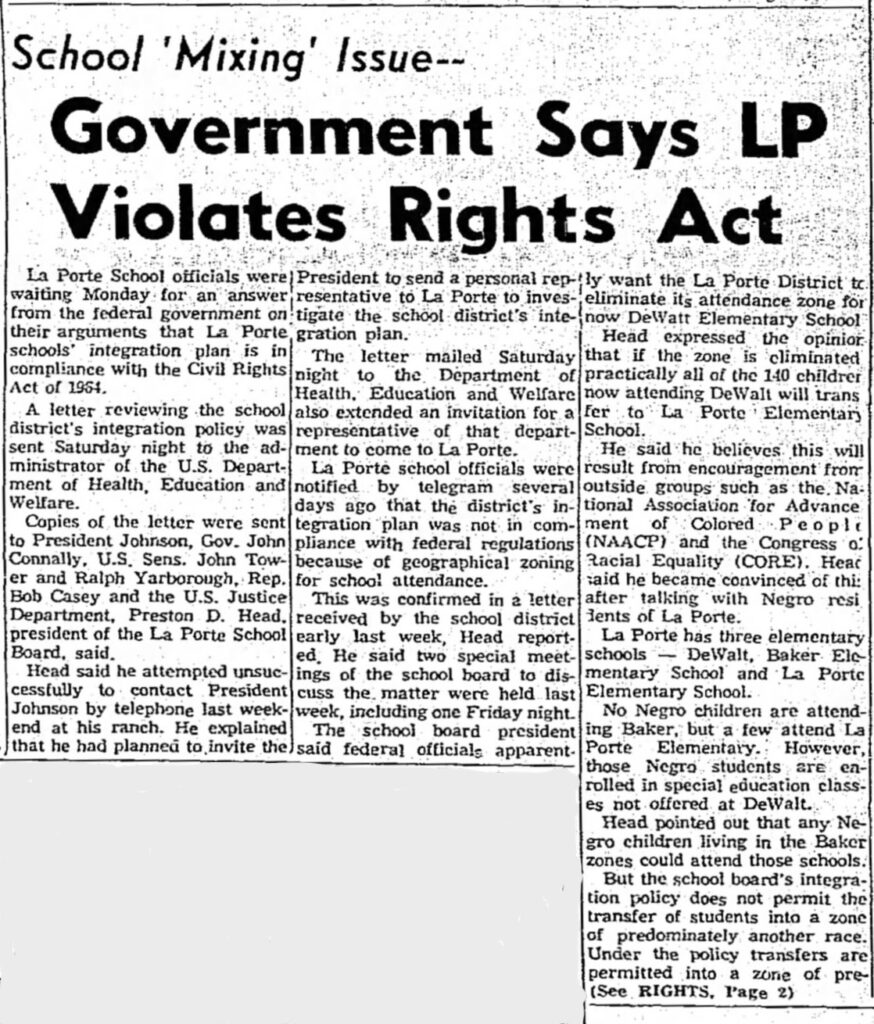
The Baytown Sun, September 27, 1965
September 1965 – La Porte School Trustees Receive Violation Notice
That would not be the case, however. Weeks before the start of the 1965-1966 school year, the La Porte School Trustees received two notices, a telegram, and a letter; they had violated the 1964 Civil Rights Act because of the geographical zoning for school attendance. The violation notices were received from both the U.S. Department of Health, Education, and Welfare and the Department of Justice. According to the notices, federal officials wanted the La Porte School District to eliminate the zone for the DeWalt School attendance.
At that time, 140 Black children were attending DeWalt School. There were no Black students at Baker Elementary and only a few at La Porte Elementary; however, those students were enrolled in special education classes, not offered at DeWalt.
The all-White members of the school board were taken by surprise, thinking they had devised a realistic plan that was in compliance with the law and served the best interests of the students, both Black and White. The Board immediately called special meetings to discuss the matter and, within days, composed a letter reviewing the District’s integration policy, along with a map of the District. The letter, which was mailed to the U.S. Department of Health, Education, and Welfare, included an invitation for a representative of that department to come to La Porte.


Outside Forces
During the Civil Rights movement in La Porte, little was said in the newspapers about the outside forces behind the integration movement, the violation, or the push to eliminate the DeWalt School zoning. However, various board members gave a few hints in interviews that the National Association for the Advancement of Colored People (NAACP) or the Congress of Racial Equality (CORE) likely influenced the Black community of La Porte from outside and within to prompt the change.
“Integration of our schools is upon us, regardless of whether or not we agree with the methods used in the past few months to bring about that fact. In view of this, I feel that in integrating it should be done in all of our schools with consideration for all, but no special consideration for any small group.
“Above all, I feel that the mechanics of the problem should be kept in the hands of the administration and the Board because I believe the community can and should handle local problems locally. Certainly, the people of La Porte can handle this peacefully and in good order. This would be another good mark on the record of a community that already has, to a great degree, the respect of its neighbors.”
— D. O. Laird, La Porte School Trustee
1965-1966 La Porte Schools
In December 1965, La Porte Superintendent of Schools Ralph Pearce received a telephone call from a representative of the U.S. Department of Health, Education, and Welfare advising him that the La Porte School District complied with the 1964 Civil Rights Act. However, even though the District complied for the 1965-1966 school year, they were warned that it might be different next year.
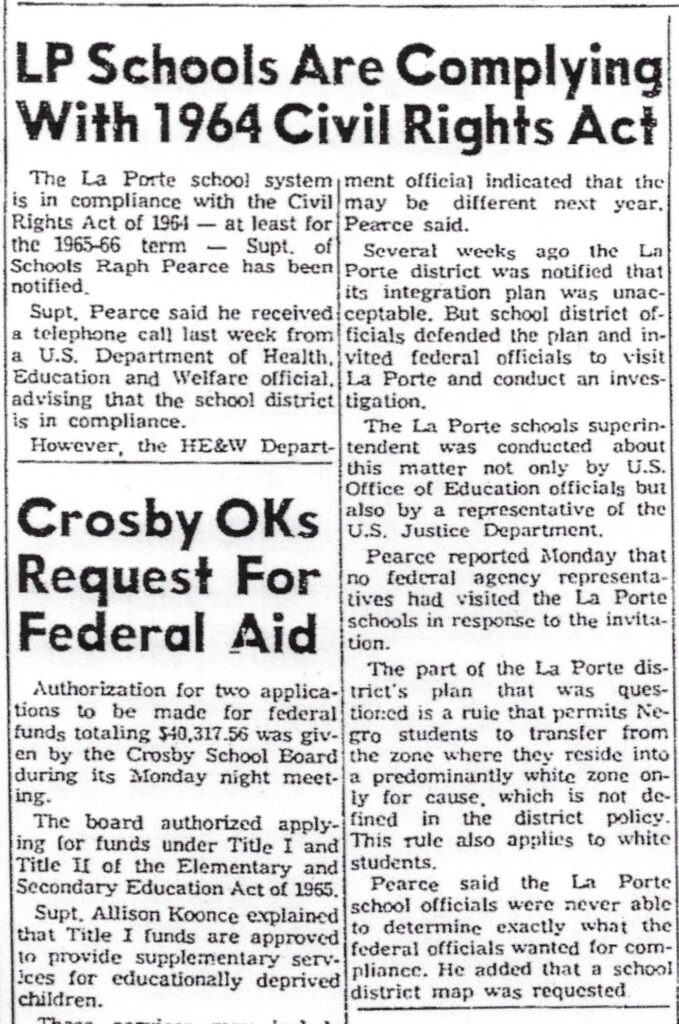
The Baytown Sun, December 21, 1965
First Black Graduates of La Porte High School
When the La Porte School District gave Black students the option to attend the all-white La Porte High School, Jessie Mae Baker and Nearly Bernard’s parents opted to allow their daughters to attend their senior year. Both girls graduated with the Class of 1964.
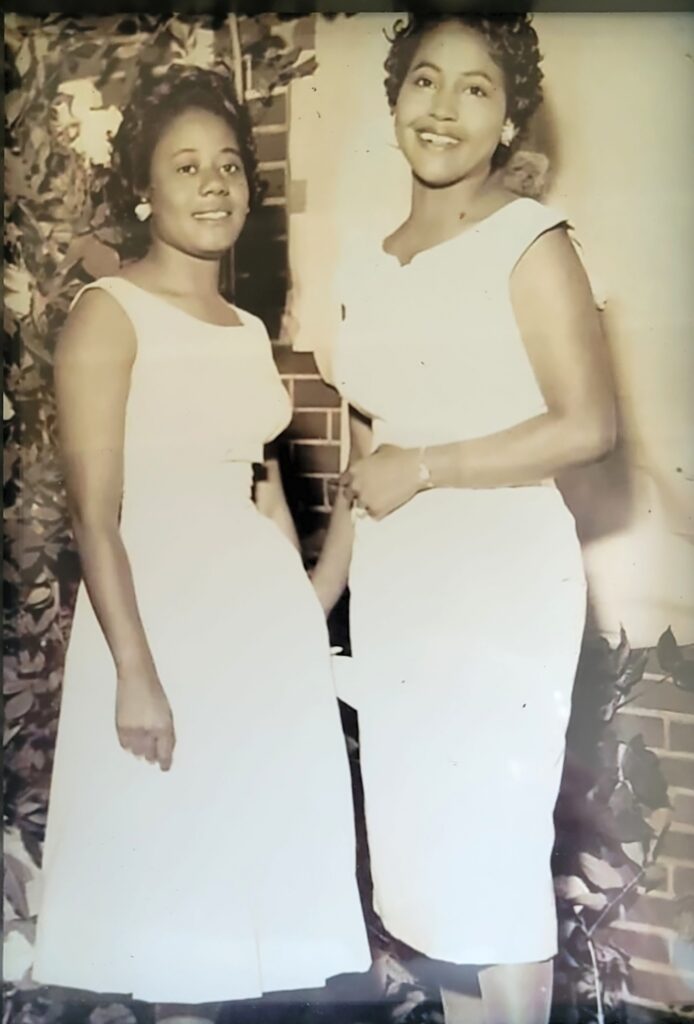
Embracing Growth: LPISD’s Commitment to Future Generations
Integration had a few bumps along the road; by the late 1960s, LPISD had successfully overcome segregation, marking a significant milestone. Moving forward, the District focused on providing the best education to all its children.
With the ever-increasing population of the La Porte community, LPISD remains steadfast in its commitment to adapt and evolve to meet the growing needs of the community.
By Georgia A. Malone, Historian
Copyright © 2025 Georgia A. Malone. All Rights Reserved.
Lorem ipsum dolor sit amet, consectetur adipiscing elit. Ut elit tellus, luctus nec ullamcorper mattis, pulvinar dapibus leo.

